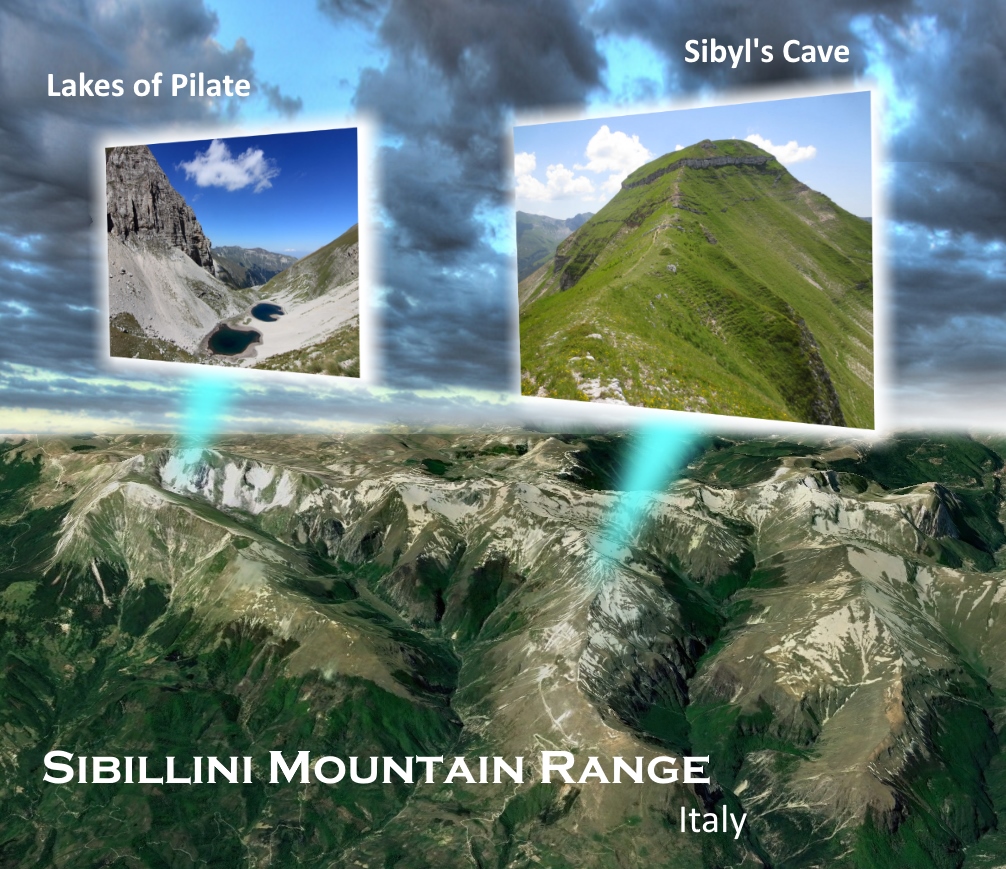27 Nov 2019
Sibillini Mountain Range, the legend before the legends /6. Treading the path to the the legendary core
In our search of the true core of the legends concerning the Sibyl's Cave and the Lakes of Pilate, we have reached a further result of remarkable significance. A result that has never been duly highlighted in any earlier research work.
Both sites, set in the same fastnesses of the Sibillini Mountain Range, in Italy, a few miles apart from one another, share a few remarkable characters, actually at least three.
First, the two of them were believed to be inhabited by legendary demonic presences.
Second, the two of them beheld the performance of necromantic rituals, also involving the summoning of the local, mythical demons.
And third, at both sites the disturbances stirred by necromancers were such that tempests and storms were raised, with devastating effects on the neighbouring land.
All this is a strong hint towards some common origin and character which seem to mark both legends.
As we already noted at the very beginning of the present article, the two legends that narrate of the Sibyl's Cave and the Lake of Pilate are usually considered as different, distinct myths, which by an odd chance seem to live only a few miles away from each other. In fact, at a first inspection there is no meaningful relation between a tale on a sibilline prophetess and sorceress who dwells within the eerie darkness of a Cave, and a narrative on a Lake which contains the body of dead Pontius Pilate, together with scores of demons.
But we have already made it clear that that Sibyl is the offspring and local representative of legendary Sebile, a typical character who appears in many chivalric poems and romances belonging to the Matter of Britain, a friend and necromantic companion of Morgan le Fay, with their apparel of hidden castles and captive knights; and that Pontius Pilate already has his own bimillennial legendary tale and burial places scattered across Europe, so that this specific Lake is nothing but an Italian version of that legend, and a local adaptation of it.
When we take out the two superimposed legendary tales, namely the narrative layer concerning the Apennine Sibyl and the layer related to Pontius Pilate, we start to perceive the common characters. The two legends now appear to share the same basical traits: a mythical demonic presence; the performance of necromantic rituals; the winds, the tempests, the devastation.
We begin to get glimpses of the original, common core of the two legends. There is something with the Cave and Lake which has nothing to do with the Apennine Sibyl and Pontius Pilate. Some thing deeper. Some thing more ancient.
We are gettin closer and closer to the true nucleus of the legends that inhabit the Sibillini Mountain Range, in Italy. However, our journey into the mystery which lies at the core is not ended yet.
After having highlighted the three listed common traits, now we need to highlight a fourth shared aspect, which we have not yet mentioned.
This is entryway. Entryway to the Otherworld.
As we will see in the next series of articles.
Monti Sibillini: la leggenda prima delle leggende /6. Sulle tracce del nucleo leggendario
Nella nostra ricerca del nucleo più vero delle leggende che riguardano la Grotta della Sibilla e i Laghi di Pilato, siamo giunti a un ulteriore risultato di rilevante significato. Un risultato che non è stato mai debitamente posto in evidenza in nessuna precedente ricerca.
Entrambi i siti, posti tra gli stessi contrafforti dei Monti Sibillini, in Italia, distanti solamente pochi chilometri l'uno dall'altro, condividono alcune interessanti caratteristiche, in particolare almeno tre specifici aspetti.
Primo: ambedue i siti erano ritenuti costituire la dimora di leggendarie presenze demoniache.
Secondo: ambedue i siti videro l'effettuazione di rituali negromantici, che comprendevano anche l'evocazione di quei favolosi demoni locali.
E, terzo: in ambedue i siti, la turbolenza suscitata dai negromanti era ritenuta tale da potere scatenare tempeste e uragani, con effetti devastanti sul territorio circostante.
Tutto ciò costituisce un indizio particolarmente significativo in merito al fatto che una qualche sorta di origine comune e di carattere condiviso debbano trovarsi alla base di entrambe le leggende.
Come abbiamo già avuto modo di notare all'inizio del presente articolo, le due leggende che narrano della Grotta della Sibilla e del Lago di Pilato sono comunemente considerate come miti differenti e distinti, i quali, per una curiosa casualità, si trovano a vivere a una distanza minima, in effetti pochi chilometri, l'uno dall'altro. E infatti, a una prima osservazione nessuna relazione parrebbe sussistere tra il racconto riguardante una maga e profetessa sibillina, la cui dimora è collocata nell'oscurità sinistra di una Grotta, e la favola di un Lago che conterrebbe il corpo morto di Ponzio Pilato, assieme a legioni di demoni.
Ma abbiamo già potuto chiarire come quella Sibilla non costituisca che la filiazione e la locale versione della leggendaria Sebile, un personaggio tipico che compare in molti poemi e romanzi cavallereschi appartenti al Ciclo di Bretagna, amica e compagna di Morgana la Fata, con il relativo apparato fatto di castelli nascosti e cavalieri imprigionati; e come Ponzio Pilato disponga già della propria bimillenaria leggenda, nonché di vari luoghi di sepoltura sparsi per l'Europa, tali da rendere questo specifico Lago la mera versione italiana di questa leggenda, e un adattamento locale della stessa.
Quando ci disponiamo a rimuovere i due strati leggendari addizionali, e dunque il livello concernente la Sibilla Appenninica e il livello relativo a Ponzio Pilato, cominciamo a discernere i tratti comuni. Le due leggende iniziano a mostrare di condividere gli stessi aspetti fondamentali: una mitica presenza demoniaca; l'effettuazione di rituali negromantici; i venti, le tempeste, le devastazioni.
Cominciamo, in effetti, a scorgere il nucleo comune, originario delle due leggende. C'è qualcosa, nella Grotta e nel Lago, che non ha nulla a che fare con la Sibilla Appenninica, né con Ponzio Pilato. C'è qualcosa di più profondo. C'è qualcosa di più antico.
Ci stiamo avvicinando sempre di più al cuore più vero delle leggende che abitano i Monti Sibillini, in Italia. Eppure, il nostro viaggio in direzione del mistero che giace all'interno di quel nucleo non è ancora finito.
Dopo avere evidenziato i tre aspetti condivisi già descritti, dobbiamo ora evidenziare un quarto tratto comune, che ancora non abbiamo mai menzionato.
È il punto di accesso. L'accesso oltremondano al regno infero.
Come avremo modo di vedere nella prossima serie di articoli.
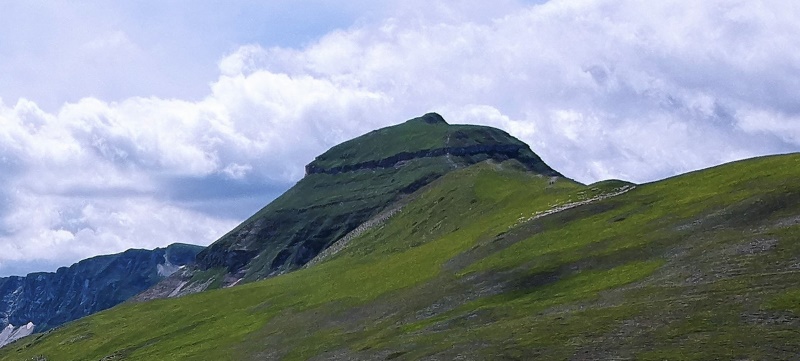

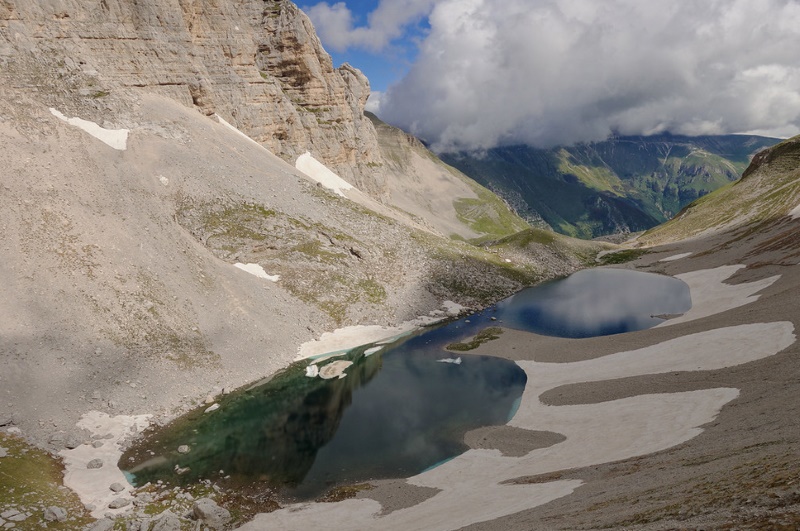

26 Nov 2019
Sibillini Mountain Range, the legend before the legends /5. Tempests as a shared feature - 5.2 Devastation arising from the cavern
Have legendary tempests and devastating storms ever originated from the Cave of the Apennine Sibyl, in today's Sibillini Mountain Range?
In the previous paragraph, we saw that this was the case for the Lake of Pilate, as attested by an ancient tradition. However, if we turn to the renowned cavern, we find no reference to such occurrences neither in Andrea da Barberino's romance “Guerrino the Wretch”, nor in Antoine de la Sale's account “The Paradise of Queen Sibyl”.
Nonetheless, we do find mentions of tempests and storms in a later excerpt concerning that cavern set on the peak of Mount Sibyl.
We read again from Crespetus' work, “De la hayne de Satan et malins esprist contro l'homme”, a book published in Paris in 1590 which contains extensive references to the Sibyl of Norcia (Fig. 1):
«The Pope has duly guarded the cavern where that Sibyl dwells, to prevent any communications with her, so that only wizards may have encounters with her out of their ability to become invisible; because when the Sibyl is addressed, by magicians or others, tempests and lightings unleash horribly on the whole territory».
[In the original French text: «Le Pape fait soigneusement garder la ditte carriere où est la ditte Sibylle, pour empescher la communication avec elle, & n'y a que ceux qui sont magiciens, & y peuvent invisiblement entrer qui la puissent aborder, à cause que quand on communique avec elle, soyt magicien ou autre, les tempestes & foudres s'esmouvent horriblement par tout le païs»].
Thus, the very same legendary occurrences which happen by the Lake of Pilate are attached to the sibilline myth as well. Necromancy and necromancers stir mighty powers from the bowels of the Sibyl's Cave, so that the neighboring land is endangered by the ruinous effects which ensue from the forbidden visits to the place.
And to his own account Crespetus adds an additional reference to the magical, divine quality of such tempests and winds, which he says he draws from «Palingenius, an Italian poet»:
«Heavenly Gods or maybe the stars themselves send those winds
Often it happens that when a Wizard wants to find treasures hidden beneath the ground
or consecrate his spellbook
or by a sorcerous ritual subjugate some god to his will,
I heard that winds raise, and sudden storms».
[In the original Latin text:
«Hos ventos vel Dii aerii vel sydera mittunt,
Sepae etenim cum thesauros tellure latentes,
Vult auferre Magus vel consecrare libellum,
Vel magico ritu quemquam sibi subdere divum,
Audivi exortum ventum, subitamque procellam»].
We will see that this supernatural character of winds, which Crespetus quotes from a sixteenth-century work, the “Zodiacus Vitae” by Marcellus Palingenius Stellatus (Fig. 2), is to be considered as an important part of the legendary core of both the Sibyl's Cave and the Lake of Pilate. But we are going too far.
For the time being, it is enough to note that the Sibyl's Cave, too, has its own storms, which are peculiarly generated by the action of necromancers, just like a well-established legendary tradition records as occurring at the Pilate's Lake.
Another shared trait. Another similar character, the third, that the two sites have in common. In the enchanted land where the fastnesses of the Sibillini Mountain Range raise.
Monti Sibillini: la leggenda prima delle leggende /5. Tempeste come elemento comune - 5.2 Devastazione che si diffonde dalla grotta
Esiste una tradizione leggendaria che racconti di tempeste e devastanti uragani che si produrrebbero presso la Grotta della Sibilla Appenninica, posta tra i Monti Sibillini?
Nel precedente paragrafo, abbiamo visto come questo sia proprio il caso del Lago di Pilato, così come attestato da un'antica tradizione. Eppure, se rivolgiamo il nostro sguardo verso la famosa caverna, non troviamo alcun riferimento a eventi di questo genere né nel romanzo di Andrea da Barberino "Guerrin Meschino", né nel "Paradiso della Regina Sibilla" di Antoine de la Sale.
Nondimeno, siamo in grado di reperire, effettivamente, un riferimento a uragani e tempeste nel contesto di un'opera più tarda che menziona proprio la Grotta situata sulla vetta del Monte Sibilla.
Andiamo ad aprire nuovamente le pagine dell'opera di Crespeto, “De la hayne de Satan et malins esprist contro l'homme”, un volume pubblicato a Parigi nel 1590, che tratta estensivamente della Sibilla di Norcia (Fig. 1):
«Il Papa fa attentamente sorvegliare la detta caverna dove si trova la citata Sibilla, al fine di impedire ogni comunicazione con essa, e dunque non ci sono che quei maghi in grado di rendersi invisibili che possano entrare in contatto con essa; perché quando essa è interpellata, sia da maghi che da altri, le tempeste e i fulmini si abbattono orribilmente su tutta la contrada».
[Nel testo originale francese: «Le Pape fait soigneusement garder la ditte carriere où est la ditte Sibylle, pour empescher la communication avec elle, & n'y a que ceux qui sont magiciens, & y peuvent invisiblement entrer qui la puissent aborder, à cause que quand on communique avec elle, soyt magicien ou autre, les tempestes & foudres s'esmouvent horriblement par tout le païs»].
Dunque, i medesimi eventi leggendari che si verificherebbero presso i Laghi di Pilato risultano caratterizzare anche il mito sibillino. La pratica della negromanzia e i negromanti sembrano in grado di suscitare immense potenze dalle viscere della Grotta della Sibilla, in modo tale che il territorio circostante viene posto a rischio dai devastanti effetti conseguenti alle visite proibite a questo sito.
E Crespeto aggiunge anche un ulteriore riferimento, relativo alla qualità magica, divina di tali venti e tempeste, citando, egli dice, da «Palingenio, un poeta italiano»:
«Gli Dèi celesti o forse le stesse stelle inviano questi venti
Spesso accade infatti che un negromante, in cerca di un tesoro nascosto sottoterra,
o desideroso di consacrare un proprio libro,
oppure tentando con un magico rituale di soggiogare una divinità,
ho udito che i venti allora si levino, e improvvise tempeste si scatenino».
[Nel testo originale latino:
«Hos ventos vel Dii aerii vel sydera mittunt,
Sepae etenim cum thesauros tellure latentes,
Vult auferre Magus vel consecrare libellum,
Vel magico ritu quemquam sibi subdere divum,
Audivi exortum ventum, subitamque procellam»].
Avremo modo di vedere come questo soprannaturale carattere dei venti, che Crespeto trae da un'opera cinquecentesca, lo "Zodiacus Vitae" di Marcello Palingenio Stellato (Fig. 2), possa essere considerato come un elemento importante del nucleo leggendario che pertiene sia alla Grotta della Sibilla che ai Laghi di Pilato. Ma stiamo precorrendo i tempi.
Per il momento, limitiamoci ad annotare come la Grotta della Sibilla abbia anch'essa le proprie tempeste, significativamente generate dall'azione dei negromanti, esattamente come si verificherebbe, secondo una ben consolidata tradizione, presso i Laghi di Pilato.
Un altro tratto condiviso. Un altro aspetto simile, il terzi, che i due siti presentano in comune. Nella terra incantata dove si innalzano i bastioni dei Monti Sibillini.
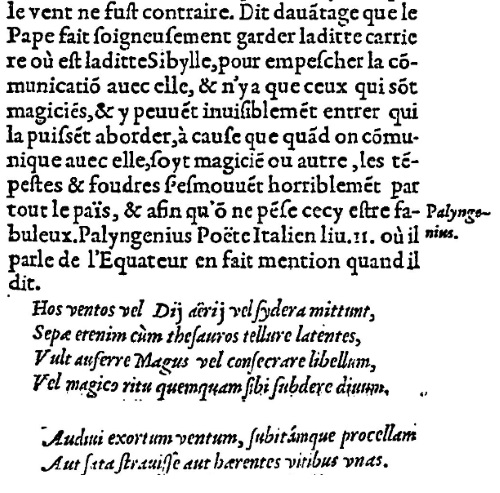

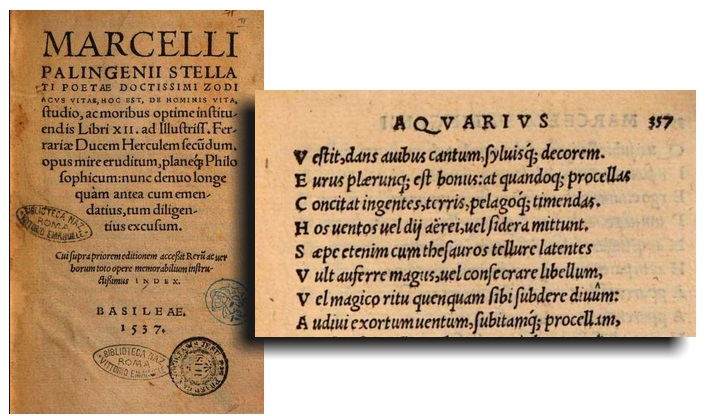

24 Nov 2019
Sibillini Mountain Range, the legend before the legends /5. Tempests as a shared feature - 5.1 Tempests and destruction raising from the lake
We are still working on our search of the common traits which mark two apparently different legends, the Sibyl's Cave and the Lakes of Pilate, both placed in the Sibillini Mountain Range, in Italy, at 5.2 miles only from each other, and in full mutual line of sight.
In our previous articles, we saw that both legends share two common aspects: necromancy performed at both sites, and legendary demons present at both places. We are now going to explore a third, stunning aspect which links the Lake and the Cave.
This third aspect is tempests and destruction. And we start from the description of the Lake as provided by Antoine de la Sale in his fifteenth-century “The Paradise of Queen Sibyl” (Fig. 1):
«That island [a rocky boulder set at the center of the lake] is strictly guarded and protected by the local people on the ground that when anybody comes to it covertly and performs the art of the Fiend, after the operation is made a storm so violent raises in the region that all crops and goods in the country get spoiled».
[In the original French text: «La quelle isle est moult gardee et deffendue des gens du pais pource que quant aucun y vient seleement et a fait son art de l'ennemy apres se fait se lieve une tempeste si grant par le pais qui gaste tous les fruiz et biens de la contree»].
So we find that necromantic arts performed at the Lake of Pilate seem to unleash some kind of unknown might: violent storms occur, and devastation of neighbouring land takes place.
Devastation arising from the Lake is also mentioned in the pages of the “Dittamondo “, a poem written by Fazio degli Uberti and dating to the fourteenth century. In a most famous excerpt, the Tuscan poet describes the effects of necromantic activities at the Lake (Fig. 2):
«I don't want to overlook the renown of the Mount of Pilate, where a lake is - which in summers is carefully guarded by watches on duty - because here Simon the Sorcerer ascends to consecrate his spellbook - so that troublesome tempests are aroused - according to what local people say».
[In the original Italian text: «la fama qui non vo’ rimagna nuda - del monte di pillato, dov’è il lago - che si guarda l'estate a muda a muda - però che qua s’intende in Simon mago - per sagrar il suo libro in su monta - onde tempesta poi con grande smago - secondo che per quei di là si conta»].
And in a fifteenth-century manuscript of the same “Dittamondo “ (Bibliothèque Nationale de France, Département des Manuscrits, Italien 81, folium 110r), in commenting a passage which mentions Norcia, its territory and the small river Torbidone, the scribe, Andrea Morena from Lodi, adds the following note (Fig. 3):
«This rivulet starts some two miles from Norcia, and it is called Torbedone, and the people in Norcia believe it flows from the lake who is visited by those who perform the art of necromancy to consecrate their spellbooks, so that for this reason the region is troubled by scourge and famine or other afflictions. Then this streamlet ends up into the river Nera some nine miles across from Norcia».
[In the original Italian text: «Questo fiumicello nasce sopra Norcia, quasi due miglia, e chiamasi Torbedone, e quelli da Norcia credono abbia il suo origine dal lago ove vanno a sacrare i libri suoi quelli che usano arte di nigromantia; però che [danno?] che surge e a loro infelice o di morbo o di carestia o de altro infortunio. E poi questo cotale fiume mette capo nella Negra (Nera) nove miglia longi da Norcia»].
And this sinister lore about storms and a ravaged land continues into the subsequent centuries. In Arnold von Harff's “Pilgrimage”, written between 1496 and 1499, the German knight writes the following words (Fig. 4):
«In former times, when the art of necromancy was abroad in the world, certain persons frequented this altar and vowed themselves to evil spirits, performing their necromancy there. Item when this happened the water of this little lake was swept up into a cloud and descended in a thunderstorm, flooding all the land for three or four miles around, so that that year was no corn there».
[In the original German text: «Vurtzijden doe die kunst der nigermancien in der werlt vmb gynck, doe lieffen dese seluigen off desen altair ind beswoeren dae den boesen geyst, drijuende dae yere nigremancie. Item as dat dan geschiet was hoyff sich off dat wasser des cleynen sees in eynen wolcken ind quam dan weder her aeff mit eyme donresslage, verdrenckende dat gantze lant dae vmbtrijnt drij off vier mylen, so dat dat jair geyn korn dae en woyss»].
Fifty years later, the dominican friar Leandro Alberti further elaborates on the subject in his work “Descrittione di tutta l'Italia” (Fig. 5):
«... the Lake of Norcia, of which unlearned people believe demons swim in it, for they repeatedly see the waters raise and lower in a way that this vision amazes those who behold the lake, as it appears to be an eerie occurrence, being veiled the reason for this motion [...] It is certainly true that if we diligently look for the reason for the said motion, we clearly see that it is the wind, which unceasingly urges the waters across the small lake surrounded by high cliffs, and owing to this urge the waters are seen to alternatively raise and lower, to the greatest amazement by the beholders».
[In the original Italian text: «... Lago di Norsa, nel quale dicono gli ignoranti nottare i diavoli, imperoché continouamente se veggiono salire et abassare l'acque di quello in tal maniera che fanno maravegliare ciascuno che le guarda, parendogli cosa sopranaturale, non intendendo la cagione di tal movimento [...] Ben è vero che cercando diligentemente la cagione de'l detto movimento de le acque, chiaramente conobbino esser i venti, i quali continouamente conducevano l'acque per il stretto Lago intorniato da alte ruppi, et così conducendole, se veddono mo alzate et poi abbassate, con gran maraviglia di che le vede»].
We may consider that these tempests and water raising and devastation seem to represent the same sort of agitations, also including hail, vapours and flames, already described across the long, millennial tradition concerning Pontius Pilate and his many troubled burial places, which we have thoroughly perused in our previous article “A legend for a Roman prefect: the Lakes of Pontius Pilate”. This is true, but only partly, because demonic unrest appears to haunt the Lake independent of the superimposed legendary tale about the Roman prefect. As we will see in the following investigation.
The earliest reference to the agitation of the waters in which Pilate had been cast is found in the “Chronica de duabus civitatibus”, written by Otto of Freising at the middle of the twelfth century: «... He [Pilate] was exiled to Vienne, the town of Gaul, and subsequently drowned into the river Rhône. From this occurrence the local people say that ships are endangered when passing by that spot» (in the original Latin text: «... Eum apud Viennam urbem Galliae in exilium trusum ac post in Rhodano mersum dicant. Unde usque hodie naves ibi periclitari ab incolis affirmantur») (Fig. 6).
The hazardous character of Pontius Pilate's burial place in the river Rhône is better detailed in a passage from twelfth-century poem “De Vita Pilati” (Fig. 7):
«It was devised that his corpse was not to be buried - it was to be brought far away and cast - into the Rhône, concealed beneath the swirling eddies of the river - But in that place frenzied commotions began to occur - so that any ship that travelled by that spot - immediately vanished into the whirlpool and sank to the abyss».
[In the original Latin text: «Hunc exstinctum non miserunt tumulari - sed procul a patria jusserunt praecipitari - in Rhodanum, latuitque diu sub fluminis unda - Sed huic mansit rabies quaedam furibunda - nam naves quaecunque locum transire volebant - gurgitis extemplo pereuntes ima petebant»].
As “De Vita Pilati” narrates, to secure the place the local residents decide to transfer that unrestful body elsewhere. So Pilate's corpse is cast into a hellish pit set in the Alps, «from which direful flames visibly erupt. - They dragged Pilate and cast him into it - to be consumed by the fire of Hell, as he deserved. - Often the voices of demons can be heard there» (in the original Latin text: «horrifer et flammas a se proferre probatur - In quem Pilatum traxerunt praecipitandum - atque gehennali, sicut decet, igne cremandum. Vox ibi multotiens auditur daemoniorum»). So the place is not quiet nor safe, and demons are the reason for all the trouble (Fig. 8).
This same agitation, now attributed to some sort of fiendish storm, is encountered at the pit, set not far from Vienne, which is mentioned by Stephen of Bourbon in his thirteenth-century “Tractatus de diversis materiis predicabilibus”: «And not far from that same place, on a mount near St. Chamon, he [Pilate] was hurled into a pit; from this pit, when a stone is thrown into it, people say vapours are issued, and storms arise» (in the original Latin text: «et ibi prope in monte supra Saint Chamon in puteo projectus; ubi, quando lapis proicitur, fumus inde egredi dicitur, de quo tempestas concitatur») (Fig. 9).
More storms are mentioned in further medieval works concerning the curse of Pontius Pilate. In a thirteenth-century anonymous commentary to the “Speculum regum”, written a century earlier by Godfrey of Viterbo, we find the following words (Fig. 10):
«His body was thrown into the river Tiber, but the demons put the town at risk with his corpse. For this reason Tiberius had his body taken off the river and brought near Amona [Vienne], where he was thrown into the river Rhône. But there, too, the demons raised many storms and hail around his corpse [...] The people took Pilate's body off the Rhône and, after having reached the mountains not far from Lausanne, in the proximity of Lucerne, hurled him into a marsh. And sure enough, when anybody throws an object, small as it may be, into the marsh [pit], at once storms and hail and lightnings and thunders hit the land».
[In the original Latin text: «Mortuus repertus in Tiberim proiectus, et demones cum corpore suo multa pericula intulerunt in patria. Quare a Tiberi levatus et iuxta Amonam [Viennam] in Rodanum ductus est et projectus; ubi similiter demones multas tempestates et grandines iuxta corpus suum fecerunt [...] Ideo patrioti experti de corpore Pilati, de Rodano receperunt et in montanis circa Losoniam prope Lucernam in quandam paludem proiecerunt. Et certum est, quod quandocumque aliquis homo aliquid quantumcumque parvum mittit in paludem [foveam], tunc in continenti fiunt tempestates, grandines, fulgura et tonitrua»].
The myth about the storms raised by the demons as they welcome the prefect's cursed body is ultimately set by the “Legenda Aurea”, written by Jacobus de Varagine at the end of the thirteenth century (Fig. 11):
«After having tied his dead body to a heavy weight, it was thrown into the river Tiber. But abominable, fiendish demons, rejoicing of that fiendish, abominable corpse, began to stir amazing waves, carrying it off now in the water and now in the air, and aroused lightnings, storms, thunders and hail up in the air so appallingly, that everybody was seized by a ghastly dread».
[In the original Latin text: «Moli igitur ingenti alligatur et in Tyberim flumen immergitur. Spiritus vero maligni et sordidi corpori maligno et sordido congaudentes et nunc in aquis nunc in aere rapientes mirabiles indundationes in aquis movebant et fulgura, tempestates, tonitrua et grandines in aere terribiliter generabant, ita ut cuncti timore horribili tenerentur»].
According the “Legenda Aurea”, after a second plunge into the Rhône and a further burial in the territory of Lausanne, the dead body of Pontius Pilate ends up its ghastly travel into a pit lost amid the mountains, possibly the Alps, «from which people say that deceptive illusions created by the demons are visible in their agitation still today» (in the original Latin text: «ubi adhuc relatione quorundam quaedam dyabolicae machinationes ebullire videntur») (Fig. 11).
We may tend to consider the agitation of the Lake of Pilate, as narrated by Antoine de la Sale, as a direct heir of the antique tradition concerning the burial place of the Roman prefect. However, this is not the case.
As a matter of fact, the narrative relating to Pontius Pilate, featuring its own troubled burial places across Europe, just met a suitable place in Italy to attach to. Because the Lake located in the glacial cirque of Mount Vettore already had its own agitated waters, even before the legendary tale about Pilate came to settle there.
We already saw that Petrus Berchorius' “Reductorium Morale”, written in the fourteenth century, provides a reference to the sinister Lake set in the Sibillini Mountain Range, without mentioning the name of Pontius Pilate at all. And demonic agitation in the waters, together with the devastating storms, is already present, in the ghastly framework of a ritual killing:
«Each year that town [Norcia] sends a single man, a living man, beyond the walls that encircle the lake, as an offering to the demons, who immediately and in full view tear apart and slaughter that man; and people say that if the town does not comply, the country would be razed by the storms».
[In the original Latin text: «Civitas illa omni anno unum hominem vivum pro tributo infra ambitum murorum iuxta lacum ad daemones mittunt, qui statim visibiliter illum hominem lacerant et consumunt, quod (ut aiunt) si civitas non facet, patria tempestatibus deperiret»].
We will come back to Berchorius' gruesome description in a future paper; for the time being, it is manifest that our Lake is as unrestful as the many resting places assigned to Pontius Pilate by his ancient legend. However, here the unrestfulness needs no presence of any Roman prefect, because this small Italian Lake is already haunted by itself, and uses to generate its own tempests and devastation of the neighbouring land.
That's what happens at the Lake set in the Sibillini Mountain Range. Does anything similar happens at the Sibyl's Cave, too?
Apparently, no reference to such disturbances seems to have ever been written by any author with respect to the cavern in which the legendary Apennine Sibyl dwells.
However, we have one. Let's see it in the following paragraph.
Monti Sibillini: la leggenda prima delle leggende /5. Tempeste come elemento comune - 5.1 Tempeste e distruzioni che sorgono dal lago
Stiamo ancora sviluppando la nostra ricerca relativa ai tratti comuni condivisi da due leggende apparentemente differenti, la Grotta della Sibilla e i Laghi di Pilato, entrambe vive tra le vette dei Monti Sibillini, in Italia, a soli 8.3 chilometri di mutua distanza, e in piena linea di vista reciproca.
Nei nostri precedenti articoli, abbiamo potuto rilevare come entrambe le leggende condividano due aspetti comuni: in ambedue i siti viene praticata la negromanzia, e demoni leggendari sarebbero presenti in entrambi i luoghi. Stiamo ora per andare a esplorare un terzo, stupefacente aspetto che collega il Lago e la Grotta.
Il terzo aspetto riguarda tempeste e distruzioni. E iniziamo dalla descrizione del Lago che ci viene fornita da Antoine de la Sale nel suo quattrocentesco "Il Paradiso della Regina Sibilla" (Fig. 1):
«Quell'isola [una grande roccia posta al centro del lago] è attentamente sorvegliata e protetta dalla gente del luogo, perché quando qualcuno vi perviene segretamente e vi pratica le arti del Demonio, subito si leva nella regione una tempesta così violenta da distruggere tutti i raccolti e i beni della contrada».
[Nel testo originale francese: «La quelle isle est moult gardee et deffendue des gens du pais pource que quant aucun y vient seleement et a fait son art de l'ennemy apres se fait se lieve une tempeste si grant par le pais qui gaste tous les fruiz et biens de la contree»].
Dunque, troviamo che l'effettuazione di pratiche negromantiche presso il Lago di Pilato parrebbe scatenare qualche genere di forza sconosciuta: violente tempeste si leverebbero, e si verificherebbero devastazioni nei territori circostanti.
Devastazioni che procedono dal Lago sono anche menzionate nelle pagine del "Dittamondo", un poema scritto da Fazio degli Uberti e risalente al quattordicesimo secolo. In un brano assai noto, il poeta toscano descrive gli effetti prodotti dalle attività negromantiche eseguite presso il Lago (Fig. 2):
«La fama qui non vo’ rimagna nuda - del monte di pillato, dov’è il lago - che si guarda l'estate a muda a muda - però che qua s’intende in Simon mago - per sagrar il suo libro in su monta - onde tempesta poi con grande smago - secondo che per quei di là si conta».
E in un manoscritto quattrocentesco contenente lo stesso "Dittamondo" (Bibliothèque Nationale de France, Département des Manuscrits, Italien 81, folium 110r), il copista Andrea Morena da Lodi, nel commentare un passaggio relativo a Norcia, al suo territorio e al suo piccolo ruscello Torbidone, aggiunge la seguente annotazione (Fig. 3):
«Questo fiumicello nasce sopra Norcia, quasi due miglia, e chiamasi Torbedone, e quelli da Norcia credono abbia il suo origine dal lago ove vanno a sacrare i libri suoi quelli che usano arte di nigromantia; però che [danno?] che surge e a loro infelice o di morbo o di carestia o de altro infortunio. E poi questo cotale fiume mette capo nella Negra (Nera) nove miglia longi da Norcia».
E questa sinistra tradizione leggendaria a proposito di tempeste e terre devastate prosegue nei secoli successivi. Nel "Pellegrinaggio" di Arnold von Harff, vergato tra il 1496 e il 1499, il cavaliere tedesco scrive le seguenti parole (Fig. 4):
«Nei tempi antichi, quando l'arte della negromanzia era diffusa nel mondo, alcuni frequentavano questo altare e si votavano agli spiriti malvagi, praticando qui la negromanzia. Quando ciò accadeva, le acque di questo piccolo lago si innalzavano in furiosi vapori, per poi ricadere nuovamente con un rombo come di tuono, inondando la circostante landa per tre o quattro miglia, così da impedire il raccolto quell'anno».
[Nel testo originale tedesco: «Vurtzijden doe die kunst der nigermancien in der werlt vmb gynck, doe lieffen dese seluigen off desen altair ind beswoeren dae den boesen geyst, drijuende dae yere nigremancie. Item as dat dan geschiet was hoyff sich off dat wasser des cleynen sees in eynen wolcken ind quam dan weder her aeff mit eyme donresslage, verdrenckende dat gantze lant dae vmbtrijnt drij off vier mylen, so dat dat jair geyn korn dae en woyss»].
Cinquanta anni dopo, il frate domenicano Leandro Alberti, nell'opera "Descrittione di tutta l'Italia", fornisce ulteriori dettagli sull'argomento (Fig. 5):
«... [il] Lago di Norsa, nel quale dicono gli ignoranti nottare i diavoli, imperoché continouamente se veggiono salire et abassare l'acque di quello in tal maniera che fanno maravegliare ciascuno che le guarda, parendogli cosa sopranaturale, non intendendo la cagione di tal movimento [...] Ben è vero che cercando diligentemente la cagione de'l detto movimento de le acque, chiaramente conobbino esser i venti, i quali continouamente conducevano l'acque per il stretto Lago intorniato da alte ruppi, et così conducendole, se veddono mo alzate et poi abbassate, con gran maraviglia di che le vede».
Potremmo considerare come queste tempeste e sollevamenti d'acque e devastazioni sembrino rappresentare il medesimo genere di turbolenze, che include anche grandini, vapori e fiamme, di cui troviamo descrizione attraverso la lunga, millenaria tradizione che concerne Ponzio Pilato e i suoi molti irrequieti luoghi di sepoltura, così come abbiamo avuto modo di conoscerli approfonditamente nel nostro precedente articolo "Una leggenda per un prefetto romano: i Laghi di Ponzio Pilato". Si tratta certamente di un'osservazione veritiera, eppure solo parzialmente, perché una demoniaca agitazione pare infestare quel Lago indipendentemente dal racconto leggendario addizionale che riguarda il prefetto romano. Come avremo modo di verificare nella seguente investigazione.
Il più antico riferimento all'agitazione delle acque nelle quali Pilato viene gettato è rinvenibile nella "Chronica de duabus civitatibus”, scritta da Ottone di Frisinga nella prima metà del dodicesimo secolo: «Egli [Pilato] fu inviato in esilio a Vienne, città della Gallia, dove si dice che egli sia stato annegato nel Rodano. E proprio per questo la gente del luogo sostiene che le navi che transitano in quella zona corrano dei pericoli» (nel testo originale latino: «Eum apud Viennam urbem Galliae in exilium trusum ac post in Rhodano mersum dicant. Unde usque hodie naves ibi periclitari ab incolis affirmantur») (Fig. 6).
Il periglioso carattere del luogo di sepoltura di Ponzio Pilato nel fiume Rodano è ulteriormente illustrato in un passaggio del poema “De Vita Pilati”, databile al dodicesimo secolo (Fig. 7):
«Fu deciso che il suo corpo non dovesse essere seppellito - ma che dovesse invece essere allontanato e gettato - nel Rodano, per essere occultato dalle correnti del fiume - Ma in quel luogo si levarono agitazioni rabbiose - tali che ogni nave che avesse inteso transitare in quel punto - subito veniva catturata dal gorgo e affondava nell'abisso».
[Nel testo originale latino: «Hunc exstinctum non miserunt tumulari - sed procul a patria jusserunt praecipitari - in Rhodanum, latuitque diu sub fluminis unda - Sed huic mansit rabies quaedam furibunda - nam naves quaecunque locum transire volebant - gurgitis extemplo pereuntes ima petebant»].
Come narrato nella "De Vita Pilati", per rendere di nuovo sicuro quel luogo la gente del luogo decide di trasferire altrove quel corpo così turbolento. E così il cadavere di Pilato viene gettato all'interno di un pozzo infernale situato tra le Alpi, «dal quale, così come si ricorda,
terrificanti fiamme visibilmente si levano - essi presero Pilato e lo precipitarono in esso - affinché fosse consumato dalle fiamme dell'Inferno, così come egli meritava. - Spesso è lì possibile udire le voci dei dèmoni» (nel testo originale latino: «horrifer et flammas a se proferre probatur - In quem Pilatum traxerunt praecipitandum - atque gehennali, sicut decet, igne cremandum. Vox ibi multotiens auditur daemoniorum»). Quel luogo, dunque, non è né quieto, né tantomeno sicuro, e la ragione di tanta agitazione sono proprio i demoni (Fig. 8).
Questa medesima agitazione, questa volta attribuita a qualche sorta di diabolica tempesta, è rilevabile anche presso l'abisso, situato non lontano da Vienne, che viene menzionato da Stefano di Borbone nel suo “Tractatus de diversis materiis predicabilibus”, risalente al tredicesimo secolo: «E lì, non distante da quei luoghi, su di una montagna prossima a Saint Chamon, egli [Pilato] fu gettato in una profonda cavità; dalla quale si racconta che, quando vi venga gettata dentro una pietra, fuoriescano vapori, e vengano suscitate tempeste» (nel testo originale latino: «et ibi prope in monte supra Saint Chamon in puteo projectus; ubi, quando lapis proicitur, fumus inde egredi dicitur, de quo tempestas concitatur») (Fig. 9).
Ulteriori tempeste sono menzionate in altre opere medievali che narrano della maledizione di Ponzio Pilato. In un anonimo commentario duecentesco allo “Speculum regum”, scritto un secolo prima da Goffredo da Viterbo, troviamo le seguenti parole (Fig. 10):
«Essendo stato trovato morto, [Pilato] fu gettato nel Tevere, ma i demoni, usando il suo corpo, posero in pericolo la città. Per questa ragione, per ordine di Tiberio il suo cadavere fu recuperato e condotto presso Amona [Vienne], e lì gettato nel Rodano. Ma anche lì i demoni sollevarono grandi tempeste e grandini attorno al suo cadavere [...] Poi la gente del luogo trasse dal Rodano il corpo di Pilato, e lo gettarono in una palude non lontano da Losanna, in prossimità di Lucerna. E pare certo che, ogni volta che qualcuno getta un oggetto, per quanto piccolo, nella palude [o pozzo], subito tempeste, grandini, folgori e tuoni si levano sulla regione».
[Nel testo originale latino: «Mortuus repertus in Tiberim proiectus, et demones cum corpore suo multa pericula intulerunt in patria. Quare a Tiberi levatus et iuxta Amonam [Viennam] in Rodanum ductus est et projectus; ubi similiter demones multas tempestates et grandines iuxta corpus suum fecerunt [...] Ideo patrioti experti de corpore Pilati, de Rodano receperunt et in montanis circa Losoniam prope Lucernam in quandam paludem proiecerunt. Et certum est, quod quandocumque aliquis homo aliquid quantumcumque parvum mittit in paludem [foveam], tunc in continenti fiunt tempestates, grandines, fulgura et tonitrua»].
Il mito relativo alle tempeste che i demoni solleverebbero nell'accogliere il cadavere maledetto del prefetto è infine codificato nella "Legenda Aurea", scritta da Jacopo da Varagine alla fine del tredicesimo secolo (Fig. 11):
«Il suo corpo fu legato a un grosso peso, e poi fu gettato nel Tevere. Ma spiriti maligni ed esecrandi, gioendo di quel cadavere maligno ed esecrando, cominciarono a suscitare straordinarie ondate, trasportandolo ora in acqua, ora nell'aria, e generando nell'aria fulmini, tempeste, tuoni e grandini in modo così terrificante, che tutti furono presi da terribile paura».
[Nel testo originale latino: «Moli igitur ingenti alligatur et in Tyberim flumen immergitur. Spiritus vero maligni et sordidi corpori maligno et sordido congaudentes et nunc in aquis nunc in aere rapientes mirabiles indundationes in aquis movebant et fulgura, tempestates, tonitrua et grandines in aere terribiliter generabant, ita ut cuncti timore horribili tenerentur»].
Secondo la "Legenda Aurea", dopo un secondo tuffo nel Rodano e un'ulteriore sepoltura nel territorio di Losanna, i resti mortali di Ponzio Pilato avrebbero terminato il loro agghiacciante viaggio in un abisso perduto tra le montagne, forse le Alpi, «presso il quale ancora oggi, secondo quanto riferito da alcuni, è possibile osservare il ribollente manifestarsi di illusioni create dai demoni» (nel testo originale latino: «Qui cum nimis praefatis infestationibus gravarentur, ipsam a se removerunt et in quodam puteo montibus circumsepto immerserunt, ubi adhuc relatione quorundam quaedam dyabolicae machinationes ebullire videntur») (Fig. 11).
Potremmo essere tentati di interpretare le turbolenze del Lago di Pilato, così come narrate da Antoine de la Sale, come una diretta eredità dell'antica tradizione che concerne il luogo di sepoltura del prefetto romano. Ma non è questo il caso.
È un dato di fatto come la narrazione relativa a Ponzio Pilato, caratterizzata da specifici luoghi di sepoltura sparsi per l'Europa, si sia semplicemente imbattuta in un luogo assai adatto, in Italia, presso il quale radicarsi. Perché il Lago posto all'interno del circo glaciale del Monte Vettore era già segnato dalle proprie liquide agitazioni, ben prima che il leggendario racconto di Pilato trovasse dimora in quelle acque.
Abbiamo già avuto modo di vedere come il "Reductorium Morale" di Petrus Berchorius, scritto nel quattordicesimo secolo, fornisca un riferimento al sinistro Lago situato tra i Monti Sibillini, senza menzionare affatto il nome di Ponzio Pilato. E la demoniaca agitazione delle acque, assieme alle devastanti tempeste, risulta essere già presente, nel raccapricciante contesto di un sacrificio rituale:
«Quella città [Norcia], ogni anno, invia un singolo uomo, vivo, oltre le mura che circondano il lago, a modo di tributo per i dèmoni, i quali subito e visibilmente lo smembrano e lo divorano; e dicono che se la città non facesse questo, il suo territorio sarebbe devastato dalle tempeste».
[Nel testo originale latino: «Civitas illa omni anno unum hominem vivum pro tributo infra ambitum murorum iuxta lacum ad daemones mittunt, qui statim visibiliter illum hominem lacerant et consumunt, quod (ut aiunt) si civitas non facet, patria tempestatibus deperiret»].
Torneremo ancora sulla macabra descrizione fornita da Berchorius in un futuro articolo; per il momento, appare manifestamente come il nostro Lago sia tanto inquieto quanto i molti luoghi di sepoltura assegnati a Ponzio Pilato dalla sua antica leggenda. Nondimeno, qui l'inquietudine delle acque non necessita della presenza di alcun prefetto romano, perché questo piccolo Lago italiano è già infestato per proprio conto, ed è solito generare le proprie tempeste, nonché le proprie devastazioni del territorio circostanze.
Questo è ciò che accade presso il Lago posto tra i Monti Sibillini. Forse qualcosa del genere ha luogo anche presso la Grotta della Sibilla?
In apparenza, sembrerebbe che nessun riferimento a una tale sorta di turbolenze sia stato mai vergato da nessun autore in relazione alla caverna all'interno della quale dimorerebbe la leggendaria Sibilla Appenninica.
Invece, abbiamo una citazione. Andiamo a vederla nel prossimo paragrafo.


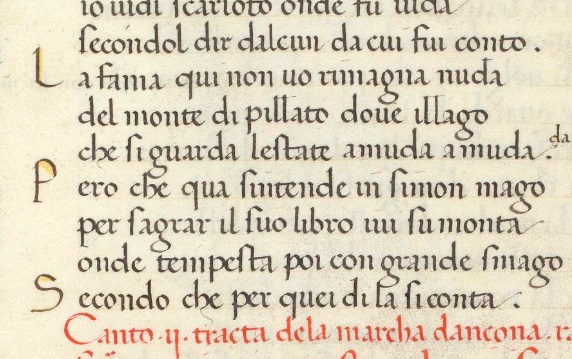



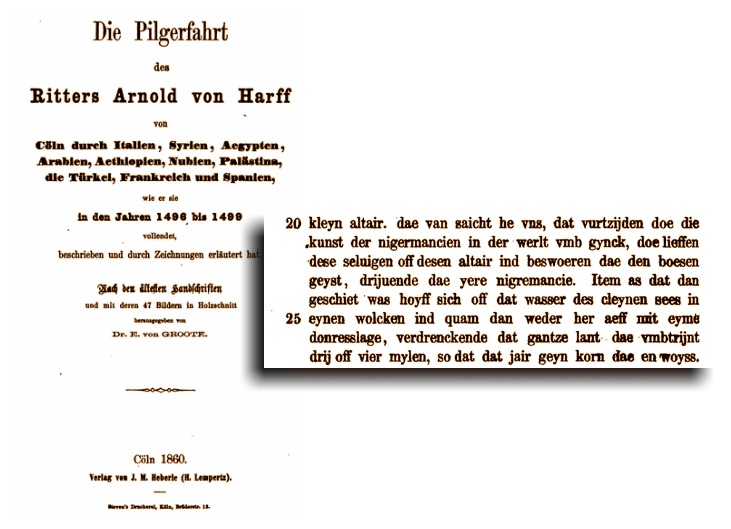

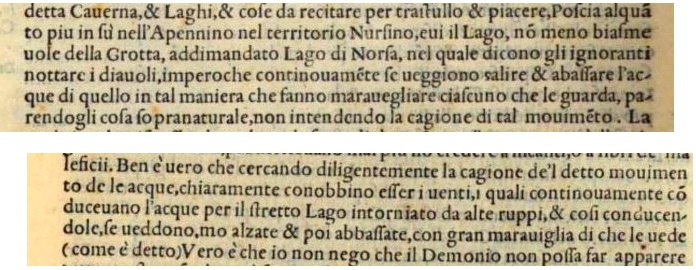

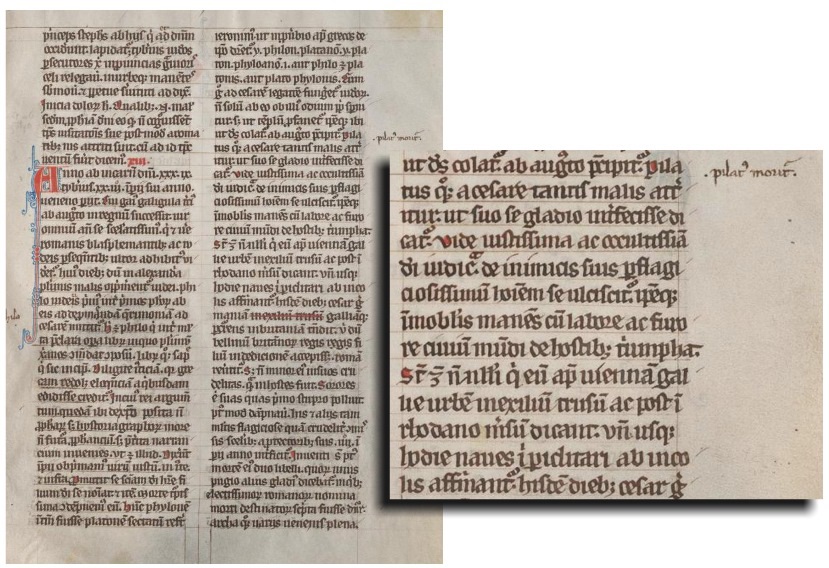

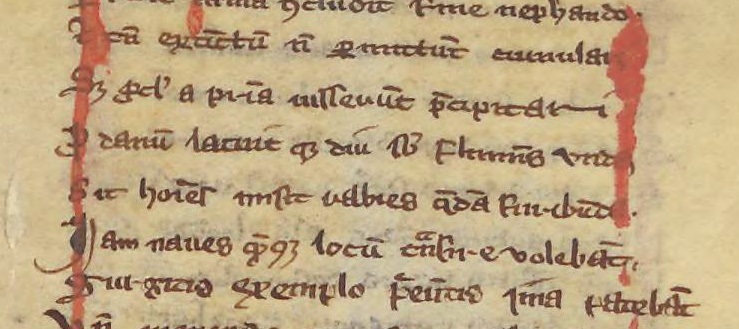







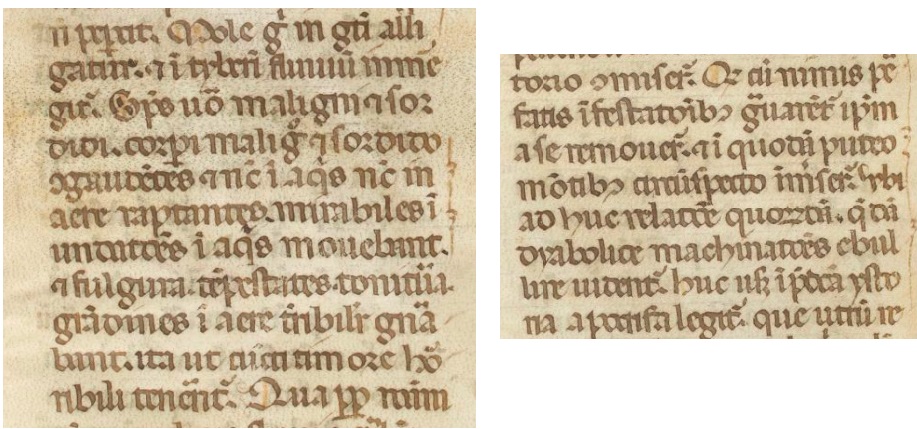



21 Nov 2019
Sibillini Mountain Range, the legend before the legends /4. Fiendish entities as a shared feature - 4.3 Sinister legendary dwellers reside at both sites
After a perusal of the main literary sources of the legends concerning the Sibyl's Cave and the Lakes of Pilate, we found out a further remarkable evidence: not only both sites are connected to the performance of necromantic rituals, but they are also inhabited by some kind of resident, legendary demons. Both of them.
As to the Lakes of Pilate (Fig. 1), this is actually no news: the whole medieval tradition concerning Pontius Pilate's burial places features lots of demons, portrayed in the act of welcoming the prefect's cursed body with unrestful agitation, as it is plunged into the waters of a river, be it the Tiber or the Rhône, or a pit set amid the Alps. And the same demons are also present in Petrus Berchorius' description of our Italian Lake nested within the Sibillini Mountain Range: yet this description bears no references at all to the renowned Roman official.
With regard to the Sibyl's Cave (Fig. 2), many contemporary scholars and authors appear to have more or less intentionally neglected or thoroughly disregarded the demonic marks of the sibilline myth. As we will see in future articles, they have rather preferred to consider the positive, matriarchal character of a wise Sibyl, in her capacity as a queen and a seer and a teacher of crafts to local communities of women: a sort of forerunner of modern feminist instances, whose image is definitely not retrievable in any of the ancient sources concerning the Sibyl of the Apennines, and has no known philological background nor the least scientific evidence.
All of the ancient retrievable manuscripted and printed sources tell a wholly different story. Sinister legendary dwellers reside at both sites. A 'good' Sibyl is never staged.
As a further confirmation to the above point, we can quote once more from the letter written by Pope Pius II Piccolomini, who in 1444 provides a reference to both sites, the Lake and the Cave; and for both he reports that «witches are found there and fiends and nocturnal wraiths; there, those who house a bold heart can hear the voices of fiendish spirits, and talk to them and learn from them the magical arts».
The Lake and the Cave. Both in the Sibillini Mountain Range, in Italy, and set a few miles from one another, in mutual line of sight. At both sites necromantic rituals are staged. And mythical demons seem to live at both places.
Similarities are beginning to pour in. And we have more than two. We also have a third. A third common trait, which is present at both sites.
And the third common trait is tempests.
Monti Sibillini: la leggenda prima delle leggende /4. Entità maligne come elemento comune - 4.3 Sinistri abitatori leggendari dimorano in entrambi i luoghi
Dopo avere consultato le principali fonti letterarie che narrano della Grotta della Sibilla e dei Laghi di Pilato, abbiamo potuto evidenziare un ulteriore significativo elemento: non solo i due siti sono entrambi legati all'effettuazione di rituali negromantici, ma essi sarebbero anche abitati da qualche genere di leggendari demoni residenti in loco. Ambedue i siti.
Per quanto riguarda i Laghi di Pilato (Fig. 1), non si tratta certamente di una nuova e inaspettata scoperta: l'intera tradizione medievale che narra dei luoghi di sepoltura di Ponzio Pilato, infatti, è caratterizzata da vere e proprie schiere di demoni, rappresentati nell'atto di accogliere, con agitata turbolenza, il corpo maledetto del prefetto mentre esso viene gettato nelle acque di un fiume, sia questo il Tevere o il Rodano, oppure in un abisso situato tra le Alpi. E gli stessi demoni sono anche presenti nella descrizione, fornitaci da Petrus Berchorius, del nostro lago italiano annidato tra i Monti Sibillini: una descrizione che, però, non riporta alcuna menzione a proposito del famoso funzionario romano.
Per quanto riguarda, invece, la Grotta della Sibilla (Fig. 2), molti ricercatori e autori contemporanei parrebbero avere sottovalutato o addirittura completamente trascurato, più o meno intenzionalmente, i segni demoniaci che marcano il mito sibillino. Come avremo modo di vedere in futuri articoli, essi hanno piuttosto preferito porre in risalto il carattere positivo, matriarcale di una saggia Sibilla, nella sua qualità di regina, veggente e maestra di saperi tradizionali conferiti alle comunità femminili locali: una sorta di anticipatrice di moderne istanze femministe, la cui immagine non è però in alcun modo rinvenibile in nessuna delle antiche fonti che riguardano la Sibilla degli Appennini, e non è supportata da alcuna rilevabile traccia filologica, né della benché minima evidenza scientifica.
Tutte le antiche fonti rintracciabili, siano esse manoscritte o a stampa, raccontano una storia del tutto differente. Sinistri abitatori leggendari dimorano in entrambi i luoghi. Nessuna 'buona' Sibilla ha mai calcato la nostra scena.
A titolo di ulteriore conferma di quest'ultima osservazione, possiamo citare ancora dalla lettera vergata da Papa Pio II Piccolomini, il quale nel 1444 fa menzione di entrambi i siti, il Lago e la Grotta; e, per entrambi, egli riferisce che «lì si trovano streghe e demoni e ombre notturne, un luogo nel quale coloro che posseggono un animo audace possono ascoltare le voci degli spiriti malvagi, parlare con loro ed apprendere le arti magiche».
Il Lago e la Grotta. Ambedue situati nei Monti Sibillini, in Italia, e posti a pochi chilometri l'uno dall'altro, in piena linea di vista reciproca. In entrambi i siti vengono effettuati rituali negromantici. E mitici demoni parrebbero abitare entrambi i luoghi.
Le analogie cominciano a fluire copiosamente. E non ne abbiamo soltanto due. Ne abbiamo anche una terza. Un terzo aspetto comune, che è presente in entrambi i siti.
E il terzo aspetto comune è costituito dalle tempeste.
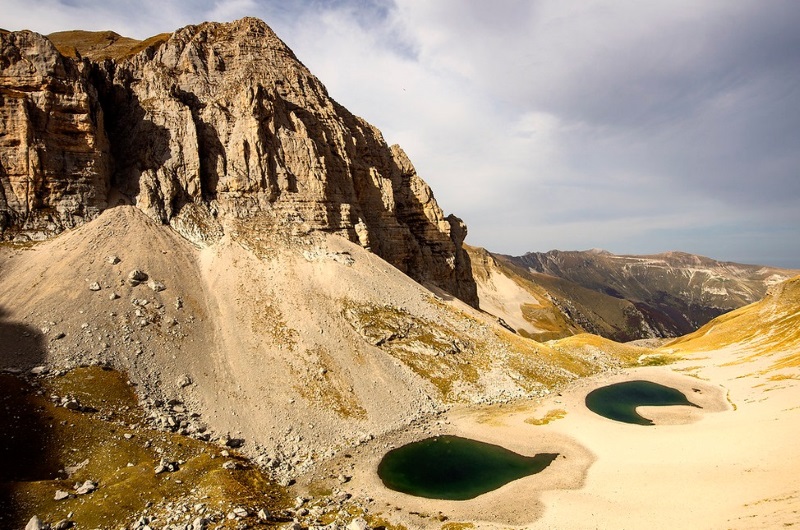

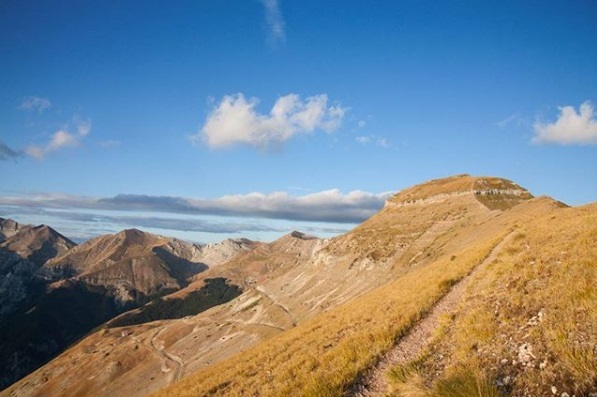

20 Nov 2019
Sibillini Mountain Range, the legend before the legends /4. Fiendish entities as a shared feature - 4.2 Mythical demons in the cavern
The legendary tale concerning the Lakes of Pilate features demons as resident entities who would inhabit the cold waters set in the middle of the Sibillini Mountain Range. Have similar demons ever inhabited the bowels of the Sibyl's Cave as well?
At first sight, the Apennine Sibyl as described by Andrea da Barberino in his romance may appear as something different. The Sibyl herself seems to openly mark a difference with demons, at least with reference to her asserted bodily nature, when she rebukes Guerrino with the following harsh words (Fig. 1):
«You false Christian, your commands can do nothing to me because I am no wraith, I have flesh and bones as you yourself [...]; go and command demons and fiedish spirits if you wish, they do not have a body».
[In the original Italian text: «O falso christiano le tue sconiuratione non me posseno nocere impero che io non sono corpo fantastico ma sono e fui de carne e ossa come che tu sei [...]; ma sconiura li demonii li quali non hano corpo e li spiriti imondi»].
However, it is clear that a fiendish might is heavily at work in the Cave. Guerrino is fully aware that the kingdom of the Sibyl, including castles and palaces and gardens, cannot exist in actual reality within the limited space of a cave, so what he was beholding within the cavern was to be considered as the result of an enchantment («vide molte castelle e molte ville molti palacii e molti ziardini et imaginò questi tutti essere incantamenti, per ché in poco loco de la montagna non era possibile che tante cose vi fosseno»). In many occasions Guerrino invokes the name of Lord Jesus as a shelter against the wicked lures offered to him by the Sibyl, asking for salvation of his soul: a clear sign that a supernatural evil is present in the cavern. In addition to that, the recurrent transformation of the queen of the place and her companions into hideous worms and serpents certainly did not provide any strong confirmation to the Sibil's earnest assertion not to be a demon.
And, as a sort of seal to the above dispute, it is Andrea da Barberino himself who indicates the nature of the place, by inserting in his narrative a powerful image at the very moment of Guerrino's entrance into the inner recesses of the cave (Fig. 2):
«He walked ahead and after a short while he found a door, made of metal, and at each side of the door a demon was sculpted, and they looked like if they were alive».
[In the original Italian text: «Pocho andò che trovò una porta di metalo et da ogni latto era Scolpito uno dimonio che propio pareano vivi»].
To further corroborate the evidence of a legendary demonic presence at the Sibyl's Cave, let's open the pages of Antoine de la Sale's “The Paradise of Queen Sibyl”, in which we find the same menacing, evil seal to the cave as the one mentioned by Andrea da Barberino in his work (Fig. 3):
«At the end of this subterranean room, two dragons are found, on the two sides, artifacts at all evidence but they really seem to be alive, except that they do not make a move, and their eyes are so brilliant that they cast much light all around».
[In the original French text: «Au bout de ceste cave, trouve l'en deux dragons, des deux lez, qui sont faiz artificiallement mais il est advis proprement quilz soient en vie, fors de tant quilz ne se bougent, et ont les yeulz si reluysans quilz donnent clarté tout entour eulx»].
Demons are at work in the cavern, and Antoine de la Sale unambiguously states that fact when he recounts the story of the long stay of a German knight in the cave (Fig. 4):
«One day [...] his heart began to bleed [..] he had acted against God's will and commandments [...] and for three hundred days he had been a companion of the Fiend, because it was clear that fiendish beings were there, owing to the fact that each Friday, after midnight, his companion abandoned him and went to the queen [...] and they all stayed in special chambers and other suitable places, turned into snakes and serpents».
[In the original French text: «Un jour [...] le cuer lui commança à douloir [...] il avoit faictes encontre son vouloir et ses commandemens [of God] [...] par l'espace de iii cens jours, pour soy acompaigner avec son ennemy, car certainement apperceut-il bien que l'ennemy estoit-il vraiement, pour ce que, quant venoit le vendred, après la mienuyt, sa compaigne se levoit d'emprès lui et s'en aloit à la royne [...] et la estoient toutes en chambres et en autres lieux ad ce ordonnez, en estat de couleuvres et de serpens».
And one of the concluding remarks of de la Sale's “The Paradise of Queen Sibyl” is against «all wraiths and Devil's contrivances [...] through which the demons used to deceive people» («toutes fantosmes et toutes deableries [...] de quoy les deables decevoient le gens»), now rendered harmless and turned into nothing thanks to the Passion of Our Lord Jesus Christ. Because, he adds, this is but a «fake Sibyl, which the Fiend by his power, and by taking advantage of our feeble faith, has rendered famous to deceive the naive people» («ceste faulse Sibille que le deable par son pouvoir a cause de nostre faible creance a mis la renommee sus pour decevoir les simples gens») (Fig. 5).
So it really appears that the Sibyl's Cave, just like the Lakes of Pilate, contains a mythical demonic presence.
As a further confirmation of this legendary tradition, the subsequent centuries will see the categorisation of the Apennine Sibyl into a very specific class of demons, as reported by a Flemish priest, Martino Delrio, in his “Disquisitionum magicarum libri sex”, published in 1599, who quotes from an earlier work written by Johannes Trithemius (Fig. 6):
«The fifth kind of demons is called subterranean: they are the ones who reside in caverns and caves and hollows placed under remote peaks. The power of such demons is utterly evil: they especially seize those who dig tunnels in search of metallic ore, and those who look for treasures hidden under the ground. They are most willing to harm human beings [...] They ask for nothing more [...] than raise terror and awe in the heart of men. We know that at times they lead simple, gullible people down into their hidden recesses under the mountains to show them splendid illusory images, as if down there would lie the abode of blessed souls, and they falsely proclaim themselves friends of mankind».
[In the original Latin text: «Quintum genus subterraneum dicitur, quod in speluncis et cavernis montiumque remotis concavitatibus demoratur. Et isti demones affectione sunt pessimi; eosque invadunt, maxime, qui puteos et metalla fodiunt, et qui thesauros in terra latentes querunt, in pernicie humani generis paratissimi [...] Nihil magis quarunt [...] quam metum hominum et admirationem. Unde habemus compertum, quod simpliciores hominum quosdam nonnumquam in sua latibula montium duxerunt, stupenda mirantibus ostendentes spectacula, et quasi beatorum ibi sint mansiones, amicos virorum se mentiuntur»].
To this fiendish class belongs the Apennine Sibyl, as explicitly stated by Martino Delrio (Fig. 7):
«It is from such guiles that the fairy tales about Mount Venus arise, which are mentioned in a letter written by Pope Pius II and in the description of a Sibyl's Cavern placed in the region of Ancona as reported by Antoine de la Sale; in addition to that, we also have a mount of the White women near Kempenfent and the “She-Elf mount” in the Netherlands; and in Italy the cave lying near Norcia with a Sibyl living in it, as recorded by Pius II in his letter n. 46».
[in the original Latin text: «Ex huiusmodi ludibriis natae sunt fabulae de monte Veneris, cuius mentio apud Pium II in epistola et Speluncae Sibyllae quam in Ancona describit Antonius de la Sale; et montis Albarum foeminarum apud Kempenfem, et in Branbantia 'den Alvinnen berch'; et in Italia de Specu Nursino et de Sibylla illic degente, cuius meminit D. Pius II [in] epistola 46...»].
And this demonic aspect of the Apennine Sibyl is fully present in the work by the French Celestinian monk Crespetus, from which we already quoted. In his treatise “De la hayne de Satan et malins esprist contro l'homme”, he recounts the criminal trial held in 1586 against Domenico Mirabelli, a necromancer who was caught on his way to Mount Sibyl. In his narrative the Sibyl is depicted as in full command of ranks of fiendish beings (Fig. 8):
«They besought the Sibyls to consecrate their books so that the evil spirits shall fulfill their commanding spells without any harm for them, that they shall become visible in the form of a handsome man; they also asked not to be forced to draw any circles in their houses nor in the fields, and that demons be ready to come to them at day or at night whenever they summoned them. They also begged the Sibyls to mark on their three spellbooks their sibilline mark, so that the books may have power enough to conjure up the said spirits».
[In the original French text: «Ils supplioient les Sibylles de consacrer leur livres à tels effects que les mauvais esprits fissent tout ce que leur seroit enjoint par leur coniuration sans faire aucun mal, apparoissans en forme de bel homme, & qu'on ne fust contrainst de faire aucun cercle n'y en leurs maisons, ny aux champs, & qu'ils fussent prompts à venir de nuist & de jour, quand ils seroient evoquez. Les supplioient aussi d'apposer à leurs dits livres de Magie, qui estoient trois en nombre, leur caractere, afin qu'ils eussent plus de puissance pour appeller lesdits esprits»].
The demonic character of the Sibyl's legend appears to be fully compatible with the similar character proper to the superimposed legend of Morgan/Sebile, as specified in our previous paper “Birth of a Sibyl: the medieval connection”. We must remember that Morgan le Fay, the illustrious ancestor of the Apennine Sibyl, was described by German poet Hartmann von Aue, more than two centuries before Andrea da Barberino and Antoine de la Sale, as a sort of evil queen who ruled over the fiendish powers of the underworld (Fig. 9):
«She lived much against God: for under her command were the birds of the wild, of forests and fields, and what is most important to me, the evil spirits, which are called demons, were all under her control [...] She also had kin deep in Hell; the devil was her companion. He paid tribute to her, even from the flames, however much she wanted. And whatever she wanted from the earthly realm, that she took enough of without any bother».
[In the original Old German text: «sÿ lebete vaſt wider got - wann es wartette jr gepot - das gefugl zu dem wilde - on walde vnd on geuilde - vnd daz mich daz maiſte - die vbeln geiſte - die da tiefln ſint genant - die waren alle vnnder jr handt [...] - auch het ſÿ mage - tieff in der helle - der teufl was jr gefelle - der ſant jr ſteure - auch aus dem feure - wieuil ſy des wolte - vnd was ſÿ haben ſolte - von erdtriche - des nam ſÿ im angſtliche - alles ſelb genug»].
From the listed excerpts, it is apparent that the legend of the Apennine Sibyl's Cave is a legend of demons, just like the mythical narrative concerning the Lakes of Pilate. At the cavern set on the peak of Mount Sibyl, people came to perform unholy rituals, and to summon the servants of the Fiend, which according to the legend the Sibyl was able to control.
The Cave and the Lake. And legendary demons in both of them. A common trait which marks both legends. A few miles from one another.
Monti Sibillini: la leggenda prima delle leggende /4. Entità maligne come elemento comune - 4.2 Demoni mitici nella caverna
Il leggendario racconto che riguarda i Laghi di Pilato pone in scena demoni in qualità di entità residenti che dimorerebbero nelle gelide acque situate tra i Monti Sibillini. È possibile che analoghi demoni abbiano abitato anche le profondità della Grotta della Sibilla?
A prima vista, la Sibilla Appenninica, così come rappresentata da Andrea da Barberino nel proprio romanzo, potrebbe apparire come qualcosa di differente. La Sibilla stessa pare frapporre una certa distanza tra se stessa e una propria eventuale natura demoniaca, quantomeno in relazione alla propria asserita corporeità, quando essa rimprovera aspramente Guerino con le seguenti parole (Fig. 1):
«O falso christiano le tue sconiuratione non me posseno nocere impero che io non sono corpo fantastico ma sono e fui de carne e ossa come che tu sei [...]; ma sconiura li demonii li quali non hano corpo e li spiriti imondi».
Nondimeno, è chiaro come un maligno potere sia pesantemente all'opera nella Grotta. Guerrino è pienamente cosciente del fatto che il regno della Sibilla, con tutti i suoi castelli e palazzi e giardini, non possa esistere nella realtà spaziale racchiusa nel limitato volume di una caverna, e di come tutto ciò che appare di fronte ai suoi occhi non sia che il risultato di un incantamento («vide molte castelle e molte ville molti palacii e molti ziardini et imaginò questi tutti essere incantamenti, per ché in poco loco de la montagna non era possibile che tante cose vi fosseno»). In diverse occasioni, Guerrino invoca il nome di Gesù Cristo a modo di protezione contro i malvagi allettamenti offertigli dalla Sibilla, pregando così per la salvezza della propria anima: un chiaro segno di come una malvagità soprannaturale sia presente nella grotta. Inoltre, la ricorrente trasformazione della regina di quei luoghi e delle sue compagne in ripugnanti vermi e serpenti non contribuiva certo a confermare la vibrante dichiarazione della Sibilla di non essere affatto un demone.
E, come ad apporre una sorta di sigillo a questo genere di discussione, è lo stesso Andrea da Barberino a indicarci la natura di quel luogo, inserendo una potente immagine nella propria narrazione, nel momento stesso dell'ingresso di Guerrino nei più profondi recessi della caverna (Fig. 2):
«Pocho andò che trovò una porta di metalo et da ogni latto era Scolpito uno dimonio che propio pareano vivi».
A titolo di ulteriore conferma dell'evidenza di una leggendaria presenza demoniaca all'interno della Grotta della Sibilla, apriamo le pagine del "Paradiso della Regina Sibilla" di Antoine de la Sale, nel quale ritroviamo il medesimo minaccioso, malvagio sigillo apposto alla grotta, esattamente come il segno menzionata da Andrea da Barberino nella propria opera (Fig. 3):
«Alla fine di questa caverna, si trovano due draghi, ai due lati, di artificiale fattura, ma essi sembrerebbero veramente essere vivi, se non fossero totalmente immobili, e i loro occhi sono così lucenti che essi spargono chiarore tutt'intorno».
[Nel testo originale francese: «Au bout de ceste cave, trouve l'en deux dragons, des deux lez, qui sont faiz artificiallement mais il est advis proprement quilz soient en vie, fors de tant quilz ne se bougent, et ont les yeulz si reluysans quilz donnent clarté tout entour eulx»].
Dunque vi sono demoni all'opera nella grotta, e Antoine de la Sale rimarca senza alcuna ambiguità questo aspetto quando egli riferisce la storia del lungo soggiorno di un cavaliere tedesco nella grotta (Fig. 4):
«Un giorno [...] cominciò a provare dolore nel proprio cuore [...] egli aveva agito contro il suo volere e i suoi comandamenti [di Dio] [...] e per trecento lunghi giorni si era accompagnato con il Nemico, perché egli poteva ben comprendere come lì abitasse veramente il Nemico, perché, quando giungeva il venerdì dopo la mezzanotte, la sua compagna lo abbandonava e si recava presso la regina [...] e lì sostavano in apposite stanze e altri luoghi appositamente apprestati, trasformati in vipere e serpenti».
[Nel testo originale francese: «Un jour [...] le cuer lui commança à douloir [...] il avoit faictes encontre son vouloir et ses commandemens [of God] [...] par l'espace de iii cens jours, pour soy acompaigner avec son ennemy, car certainement apperceut-il bien que l'ennemy estoit-il vraiement, pour ce que, quant venoit le vendred, après la mienuyt, sa compaigne se levoit d'emprès lui et s'en aloit à la royne [...] et la estoient toutes en chambres et en autres lieux ad ce ordonnez, en estat de couleuvres et de serpens».
E una delle considerazioni finale di de la Sale nel "Paradiso della Regina Sibilla" è dedicata a «tutte le apparizioni e invenzioni diaboliche [...] attraverso le quali i demoni ingannano gli uomini» («toutes fantosmes et toutes deableries [...] de quoy les deables decevoient le gens»), ora rese innocue e inefficaci grazie alla Passione di Nostro Signore Gesù Cristo. Perché, aggiunge lo scrittore provenzale, questa non è che una «falsa Sibilla, che il Demonio, con il suo potere e approfittando della nostra fragile fede, ha reso famosa allo scopo di ingannare la gente semplice»(«ceste faulse Sibille que le deable par son pouvoir a cause de nostre faible creance a mis la renommee sus pour decevoir les simples gens») (Fig. 5).
Dunque, appare chiaro come anche la Grotta della Sibilla, proprio come il Lago di Pilato, contenga al proprio interno una mitica presenza demoniaca.
A titolo di ulteriore conferma di questa leggendaria tradizione, i secoli successivi vedranno la classificazione della Sibilla Appenninica all'interno di una ben specifica classe di demoni, così come riferito dall'ecclesiastico fiammingo Martino Delrio, nel suo “Disquisitionum magicarum libri sex”, pubblicato nel 1599, il quale cita un brano in precedenza vergato da Johannes Trithemius (Fig. 6):
«Il quinto genere è chiamato sotterraneo: coloro che dimorano nelle spelonche e caverne e cavità delle remote montagne. E questi dèmoni sono estremamente pericolosi: si impadroniscono specialmente di coloro che scavano gallerie e cercano metalli, e di chi è alla ricerca di tesori nascosti sotto la terra: sono particolarmente desiderosi di nuocere al genere umano [...] Essi non chiedono di meglio [...] che suscitare terrore e stupefazione nel cuore degli uomini. È noto inoltre che in alcuni casi essi abbiano condotto uomini tra i più semplici fino ai segreti recessi delle loro montagne, mostrando loro meravigliose illusioni: come se ivi fossero da trovarsi le aule degli uomini beati, e dichiarandosi, mentendo, amici degli uomini».
[Nel testo originale latino: «Quintum genus subterraneum dicitur, quod in speluncis et cavernis montiumque remotis concavitatibus demoratur. Et isti demones affectione sunt pessimi; eosque invadunt, maxime, qui puteos et metalla fodiunt, et qui thesauros in terra latentes querunt, in pernicie humani generis paratissimi [...] Nihil magis quarunt [...] quam metum hominum et admirationem. Unde habemus compertum, quod simpliciores hominum quosdam nonnumquam in sua latibula montium duxerunt, stupenda mirantibus ostendentes spectacula, et quasi beatorum ibi sint mansiones, amicos virorum se mentiuntur»].
A questa maligna classe appartiene la Sibilla Appenninica, come esplicitamente affermato da Martino Delrio (Fig. 7):
«È proprio da questi inganni che si sono originate le favole a proposito del monte di Venere, di cui si fa menzione nella lettera di Papa Pio II e nella descrizione della Grotta della Sibilla nella regione di Ancona riportata da Antoine de la Sale; e anche della montagna delle femmine Bianche vicino Kempenfent, e del 'monte delle Donne elfiche' nel Brabante; e in Italia a proposito della Caverna di Norcia e della Sibilla che lì risiederebbe, della quale fece menzione Pio II nell'epistola 46».
[Nel testo originale latino: «Ex huiusmodi ludibriis natae sunt fabulae de monte Veneris, cuius mentio apud Pium II in epistola et Speluncae Sibyllae quam in Ancona describit Antonius de la Sale; et montis Albarum foeminarum apud Kempenfem, et in Branbantia 'den Alvinnen berch'; et in Italia de Specu Nursino et de Sibylla illic degente, cuius meminit D. Pius II [in] epistola 46...»].
E questo tratto demoniaco proprio della Sibilla Appenninica è pienamente presente nell'opera del monaco celestiniano francese Crespetus, dal quale abbiamo già avuto modo di trarre citazioni. Nel suo trattato “De la hayne de Satan et malins esprist contro l'homme”, egli ripercorre il processo criminale tenutosi nel 1586 contro Domenico Mirabelli, un negromante che fu catturato mentre si recava al Monte Sibilla. Nel suo racconto, la Sibilla viene rappresentata come un'entità in grado di comandare schiere di esseri maligni (Fig. 8):
«Essi supplicavano le Sibille di consacrare i loro libri in modo tale che gli spiriti maligni facessero tutto ciò che fosse loro ingiunto nel corso dell'evocazione senza loro nuocere, apparendo in piacevole forma di uomo; essi chiesero di non essere costretti a tracciare alcun circolo, né nelle loro case, né all'aperto, e che i demoni fossero pronti a venire di notte come di giorno, quando fossero stati evocati. Le supplicavano inoltre di apporre ai loro libri magici, che erano in numero di tre, il proprio marchio, affinché essi risultassero più potenti al fine di poter richiamare i detti spiriti».
[Nel testo originale francese: «Ils supplioient les Sibylles de consacrer leur livres à tels effects que les mauvais esprits fissent tout ce que leur seroit enjoint par leur coniuration sans faire aucun mal, apparoissans en forme de bel homme, & qu'on ne fust contrainst de faire aucun cercle n'y en leurs maisons, ny aux champs, & qu'ils fussent prompts à venir de nuist & de jour, quand ils seroient evoquez. Les supplioient aussi d'apposer à leurs dits livres de Magie, qui estoient trois en nombre, leur caractere, afin qu'ils eussent plus de puissance pour appeller lesdits esprits»].
Questo carattere demoniaco della leggenda della Sibilla appare essere del tutto compatibile con i tratti analoghi tipici della narrazione addizionale concernente Morgana/Sebile, così come descritta nel nostro precedente articolo "Nascita di una Sibilla: la traccia medievale". Dobbiamo infatti ricordare come Morgana la Fata, l'illustre ascendente della Sibilla Appenninica, sia stata descritta dal poeta tedesco Hartmann von Aue, più di due secoli prima di Andrea da Barberino e Antoine de la Sale, come una sorta di malvagia regina che presiedeva alle potenze demoniache del sottosuolo (Fig. 9):
«Essa viveva marcatamente contro Dio: perché sotto il suo comando erano gli uccelli delle terre selvagge, dei boschi e dei campi, e ciò che è più importante per me, gli spiriti maligni, che sono chiamati dèmoni, erano sotto il suo controllo [...] Essa aveva anche comunanza con il profondo dell'Inferno, il demonio le era compagno. Egli era costretto a obbedirle, anche se protetto dalle fiamme, e tutto ciò che avesse desiderato dal reame della terra, lei avrebbe potuto ottenerlo senza contrasto».
[Nel testo originale in antico tedesco: «sÿ lebete vaſt wider got - wann es wartette jr gepot - das gefugl zu dem wilde - on walde vnd on geuilde - vnd daz mich daz maiſte - die vbeln geiſte - die da tiefln ſint genant - die waren alle vnnder jr handt [...] - auch het ſÿ mage - tieff in der helle - der teufl was jr gefelle - der ſant jr ſteure - auch aus dem feure - wieuil ſy des wolte - vnd was ſÿ haben ſolte - von erdtriche - des nam ſÿ im angſtliche - alles ſelb genug»].
Come si può osservare nei brani qui riportati, è evidente come la leggenda della Grotta della Sibilla Appenninica sia una leggenda di demoni, proprio come la narrazione mitica concernente i Laghi di Pilato. A quella caverna, posta sulla vetta del Monte Sibilla, i visitatori si recavano per eseguire empi rituali, e per convocare i servitori del Nemico, che, secondo la leggenda, la Sibilla era in grado di controllare.
La Grotta e il Lago. E demoni leggendari dimoranti in entrambi i luoghi. Un tratto condiviso che marca le due leggende. A pochi chilometri di distanza l'una dall'altra.


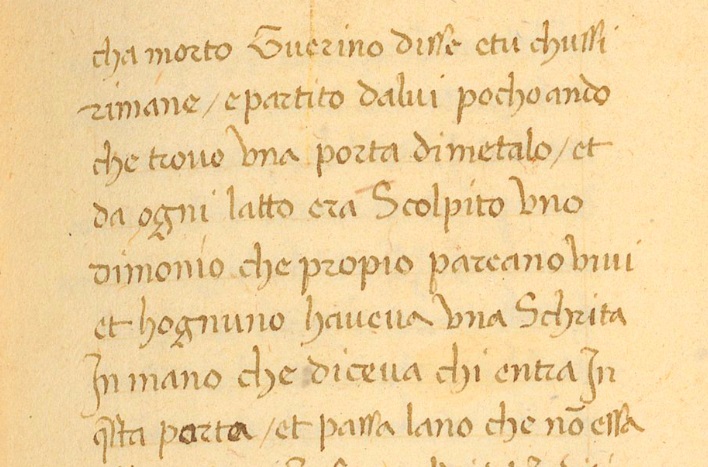

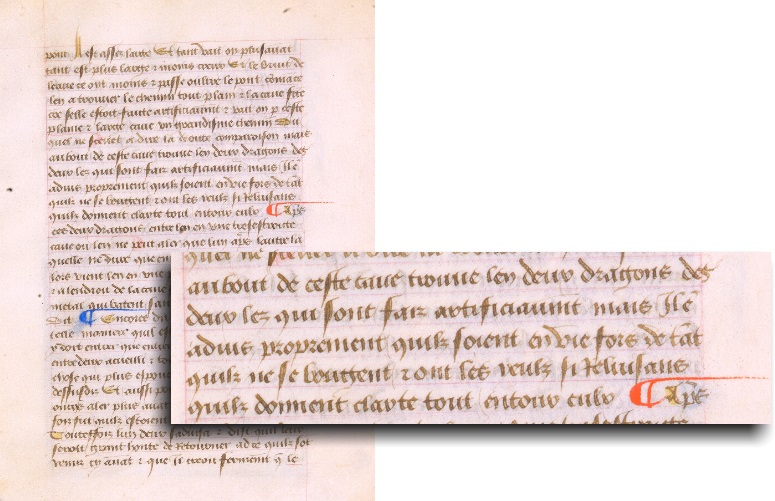

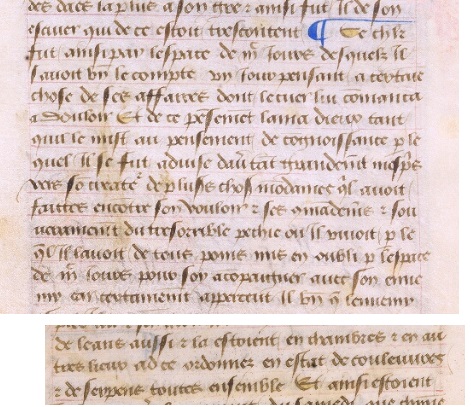

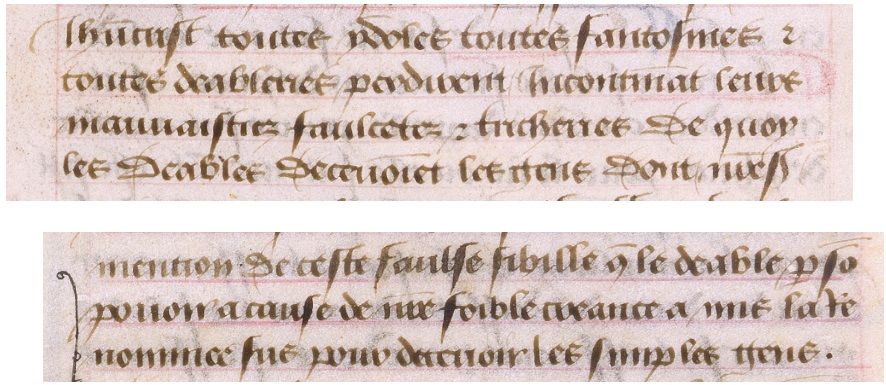

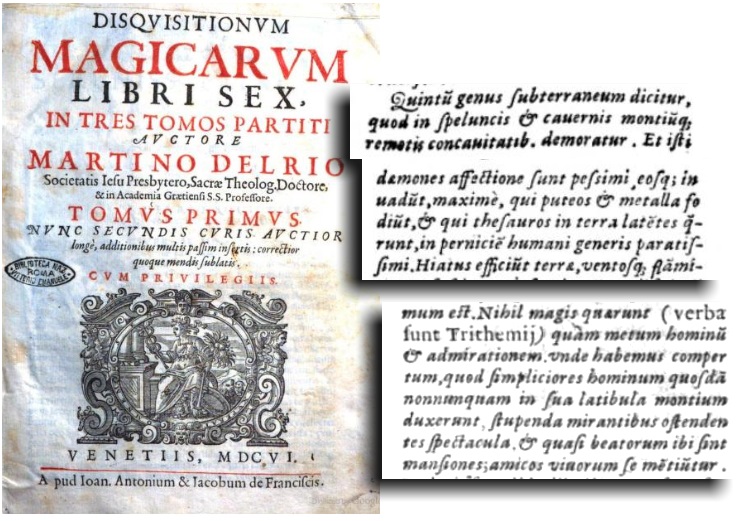

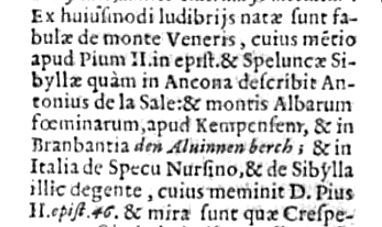

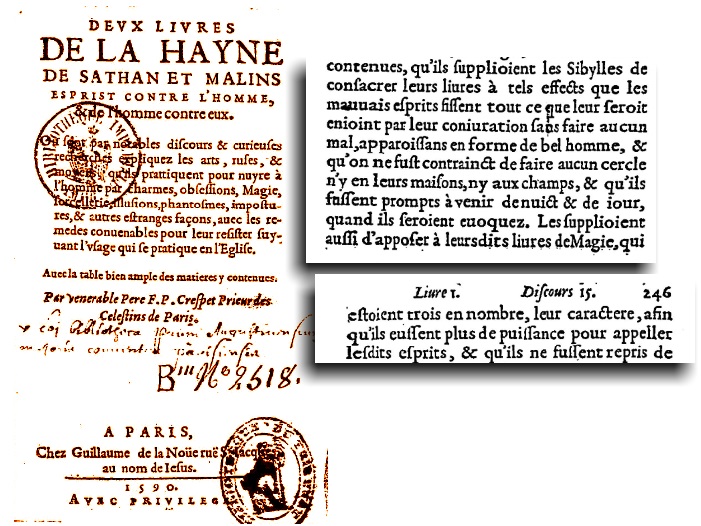

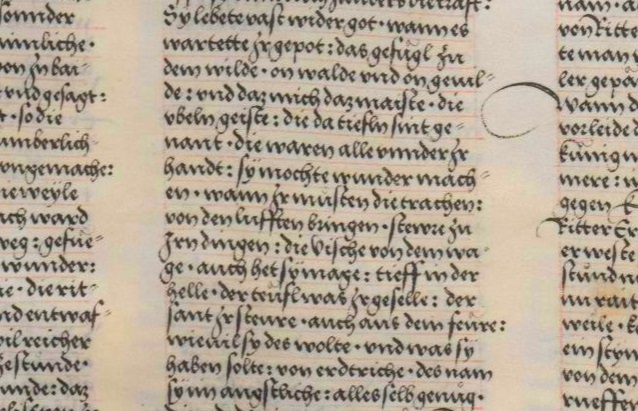

17 Nov 2019
Sibillini Mountain Range, the legend before the legends /4. Fiendish entities as a shared feature - 4.1 Mythical demons under the water
In the previous chapter, we explored necromancy as a shared character featured by both legendary tales which live in the Sibillini Mountain Range, in central Italy. According to a number of sources, people used to attend not only the Lakes of Pilate, but also the Sibyl's Cave with the aim to perform magical rituals, consecrate spellbooks and conjure up some kind of evil entities, looking for power, fame, riches, and other wordly advantages.
Thus, people used to visit those places in search of a forbidden contact with unholy beings.
Of course, no such entities have ever inhabited the crystal-clear waters of the Lakes of Pilate in actual reality, this is but a gloomy legendary tale. Yet, the notion certainly marks this place, odd as it may appear. But what sort of legendary beings were the visitors to the Lake so eager to meet?
According to the many literary sources we already quoted from in our previous research papers, a belief was widespread that demons lived at both the Lake and Cave.
The renown of the Lake of Pilate as an abode for unquiet demons is attested ever since the earliest mentions of the legend, and this sinister feature perfectly matches the superimposed literary tradition and lore concerning the cursed body of Pontius Pilate, which features its own agitated demons.
As fully described in our previous paper “A legend for a Roman prefect: the Lakes of Pontius Pilate”, the issue concerning how to dispose of the loathsome corpse of the roman prefect who sentenced Jesus Christ to death led to the elaboration, across many centuries, of a complex narrative, whose apex is to be retrieved in the “Legenda Aurea” written by Jacobus de Varagine, dating to the end of the thirteenth century. In this work, Pontius Pilate's body is initially thrown into the river Tiber, then into the river Rhône, subsequently in the territory of Lausanne, and eventually into a pit in the Alps.
At each of the listed stages, demons are always present to welcome the cursed corpse, as shown in the following excerpts (Fig. 1):
«But abominable, fiendish demons, rejoicing of that fiendish, abominable corpse, began to stir amazing waves [in the Tiber] [...] But the evil spirits did not desert this place, just like it had occurred in Rome: they acted the same way, so the people there, unable to bear such a haunting plague of demons [in the Rhône] [...] They were overwhelmed by that same plague as described before [in Lausanne] [...] they hurled the body into a certain pit set amid the mountains, from which people say that deceptive illusions created by the demons are visible in their agitation still today [in the Alps]».
[In the original Latin text: «Spiritus vero maligni et sordidi corpori maligno et sordido congaudentes et nunc in aquis nunc in aere rapientes mirabiles indundationes in aquis movebant [...] Sed ibi nequam spiritus effluunt, ibidem eadem operantes, homines ergo illi tantam infestationem daemonum non ferentes [...] Qui cum nimis praefatis infestationibus gravarentur [...] in quodam puteo montibus circumsepto immerserunt, ubi adhuc relatione quorundam quaedam dyabolicae machinationes ebullire videntur»].
In the long story of the legend of Pontius Pilate across the centuries, his many resting places have always been haunted by the presence of demons, an idea which is also contained in the eleventh-century “Rescriptum Tiberii”, also known as the “Epistola Tiberii ad Pilatum”, in which chief priest Caiaphas dies during his journey into exile and, when buried, the ground refuses to receive his corpse, and casts him out.
We find a reference to these same demonic inhabitants in Antoine de la Sale's description of our Lake set in the Sibillini Mountain Range. In the printed version of “The Paradise of Queen Sibyl”, published in 1527, necromancers are staged while the reach the boulder at the center of the Lake to perform their abominable rituals (Fig. 2):
«... Those who reached the small island to consecrate their books to conjure up the devils...»
[In the original French text: «... ceuls qui aloyent en l'islecte consacrer leurs livres pour invocquer les dyables...»].
In 1474 Flavio Biondo fully confirms this sinister fame by writing the following words in his “De Italia illustrata” (Fig. 3):
«Not much higher in the Apennines that renowned lake is found, in the territory of Norcia, in which according to a silly, fake rumour the place would be replete of evil spirits rather than fish».
[In the original Latin text: «paulo superius est lacus ille in nursinorum agri appenino, quem vano ferunt mendacio piscium loco daemonibus scatere»].
In Leandro Alberti's “Descrittione di tutta l'Italia”, published in 1550, we find the following passages (Fig. 4):
«On the eastern side of this remarkably tall mountain [Mount Vettore], that renowned Lake is to be seen, of which people say that demons are conjured up under the command of enchanters, who speak to them. [...] Then further high above in the Apennines, in the land of Norcia, there is the Lake [...] which is called the Lake of Norcia, of which unlearned people believe demons swim in it [...] here Demons live, and provide answers when addressed».
[In the original Italian text: «Vedesi alla parte de quest'altissimo monte [Monte Vettore], che riguarda all'oriente, quel tanto famoso Lago del quale se dice che vi appareno i demoni costretti dagli incantatori, et che qui vi parlano con essi. [...] Poscia alquanto più in su nell'Apennino nel territorio Nursino, evi il Lago [...] addimandato Lago di Norsa, nel quale dicono gli ignoranti nottare i diavoli [...] quivi soggiornano i Diavoli, et danno risposta a chi gli interroga»].
Additional references are easily found in other authors, including Pope Pius II Piccolomini; yet we must consider that legendary demons are present at this site even before the legendary tale of Pontius Pilate settled in this remote Italian lake. According to Petrus Berchorius and his fourteenth-century “Reductorium Morale”, from which we already quoted, fiendish beings already manifestly inhabit the icy waters of the Lake (Fig. 5):
«Amid the peaks which raise near that town [Norcia] there is a lake, which from antique times is sacred to demons and conspicuously inhabited by them».
[In the original Latin text: «Inter montes isti civitati [Norcia] proximos esse lacum ab antiquis daemonibus consecratum et ab ipsis sensibiliter inhabitatum»].
The Lake and the demons: an inseparable relationship, mythical as it may be. We will see that, together with necromancy, this feature will allow our investigation to progress further in search of the true meaning which lies behind the legend.
But what about the Sibyl's Cave? Is it likewise inhabited by legendary demons?
The answer, of course, is yes. Another common trait which the Cave shares with the Lake.
Monti Sibillini: la leggenda prima delle leggende /4. Entità maligne come elemento comune - 4.1 Demoni mitici sotto le acque
Nel precedente capitolo, abbiamo avuto occasione di esplorare la negromanzia nella sua qualità di tratto condiviso caratterizzante entrambe le leggende che abitano i Monti Sibillini, nel centro dell'Italia. Come riferito da varie fonti, sia i Laghi di Pilato che la Grotta della Sibilla ricevevano visite da parte di malevoli personaggi, i quali effettuavano magici rituali, consacravano libri d'incantesimi ed evocavano sconosciuti esseri maligni, al fine di ottenere potere, fama, ricchezze e altri vantaggi mondani.
Dunque, questi visitatori si recavano presso questi luoghi in cerca di un contatto proibito con empie entità.
Naturalmente, nessuna inesistente e illusoria entità del genere ha mai realmente dimorato nelle acque cristalline dei Laghi di Pilato, trattandosi solamente di un tenebroso racconto leggendario. Nondimeno, l'idea segna certamente questi luoghi, per quanto assurda essa possa sembrare. Ma quale sorta di leggendarie entità, quei visitatori al Lago, erano così desiderosi di incontrare?
Secondo le numerose fonti letterarie da noi già menzionate nei nostri articoli di ricerca, una diffusa credenza pareva affermare che sia nel Lago che nella Grotta vivessero esseri demoniaci.
La fama del Lago di Pilato come dimora per inquiete forze demoniache è attestata sin dalle più risalenti menzioni della leggenda, e questa sinistra caratteristica si inserisce perfettamente nella sovrapposta tradizione letteraria concernente il corpo maledetto di Ponzio Pilato, che è caratterizzata dai propri specifici e agitatissimi demoni.
Come abbiamo avuto modo di illustrare nel nostro precedente articolo "Una leggenda per un prefetto romano: i Laghi di Ponzio Pilato", la delicata questione relativa a come trattare il ripugnante cadavere del prefetto romano che aveva condannato Gesù Cristo a morte aveva condotto all'elaborazione, attraverso molti secoli, di una complessa narrazione, il cui apice può essere rintracciato nella "Legenda Aurea", scritta da Jacopo da Varagine e risalente alla fine del tredicesimo secolo. In quest'opera, il corpo di Ponzio Pilato viene inizialmente gettato nel fiume Tevere, poi nel fiume Rodano, successivamente nel territorio di Losanna, e infine in un abisso situato tra le Alpi.
In ognuna delle predette tappe, i demoni sono sempre presenti per accogliere quel cadavere maledetto, come descritto nei seguenti brani (Fig. 1):
«Ma spiriti maligni ed esecrandi, gioendo di quel cadavere maligno ed esecrando, cominciarono a suscitare straordinarie ondate [nel Tevere] [...] Ma gli spiriti malvagi non disertarono nemmeno questo luogo, presso il quale essi operarono proprio come a Roma: e così quegli uomini, non potendo sopportare una tale infestazione di demoni [nel Rodano] [...] Ma coloro [a Losanna] che subirono la medesima infestazione già in precedenza descritta [...] gettarono quel corpo in un certo abisso circondato dalle montagne, presso il quale ancora oggi, secondo quanto riferito da alcuni, è possibile osservare il ribollente manifestarsi di illusioni create dai demoni [nelle Alpi]».
[Nel testo originale latino: «Spiritus vero maligni et sordidi corpori maligno et sordido congaudentes et nunc in aquis nunc in aere rapientes mirabiles indundationes in aquis movebant [...] Sed ibi nequam spiritus effluunt, ibidem eadem operantes, homines ergo illi tantam infestationem daemonum non ferentes [...] Qui cum nimis praefatis infestationibus gravarentur [...] in quodam puteo montibus circumsepto immerserunt, ubi adhuc relatione quorundam quaedam dyabolicae machinationes ebullire videntur»].
Nella lunga vicenda della leggenda di Ponzio Pilato attraverso i secoli, i suoi numerosi luoghi di sepoltura sono sempre stati infestati dalla presenza di demoni, un'immagine che è anche contenuta nel "Rescriptum Tiberii", noto anche come “Epistola Tiberii ad Pilatum”, risalente all'undicesimo secolo, in cui il sommo sacerdote Caifa muore nel corso del suo viaggio verso l'esilio e, quando si tenta di seppellirlo, la terra si rifiuta di ricevere il suo corpo, e lo rigetta.
Troviamo un riferimento alle stesse demoniache presenze anche nella descrizione del Lago, posto tra i Monti Sibillini, fornitaci da Antoine de la Sale. Nella versione a stampa dell'opera "Il Paradiso della Regina Sibilla", pubblicata nel 1527, i negromanti vengono rappresentati mentre raggiungono la grande roccia posta al centro del Lago per eseguire i propri abominevoli rituali (Fig. 2):
«... Coloro che si recavano sulla piccola isola per consacrare i loro libri per invocare i demoni...»
[Nel testo originale francese: «... ceuls qui aloyent en l'islecte consacrer leurs livres pour invocquer les dyables...»].
Nel 1474 Flavio Biondo ci fornisce piena conferma a proposito di questa sinistra fama vergando le seguenti parole nel suo "De Italia illustrata" (Fig. 3):
«Non molto più in alto nell'Appennino, si trova quel lago nel territorio di Norcia, nel quale secondo una vana dicerìa pullulerebbero più demoni che pesci».
[Nel testo originale latino: «paulo superius est lacus ille in nursinorum agri appenino, quem vano ferunt mendacio piscium loco daemonibus scatere»].
Nella “Descrittione di tutta l'Italia” di Leandro Alberti, pubblicata nel 1550, troviamo i seguenti passaggi (Fig. 4):
«Vedesi alla parte de quest'altissimo monte [Monte Vettore], che riguarda all'oriente, quel tanto famoso Lago del quale se dice che vi appareno i demoni costretti dagli incantatori, et che qui vi parlano con essi. [...] Poscia alquanto più in su nell'Apennino nel territorio Nursino, evi il Lago [...] addimandato Lago di Norsa, nel quale dicono gli ignoranti nottare i diavoli [...] quivi soggiornano i Diavoli, et danno risposta a chi gli interroga».
Ulteriori menzioni possono essere facilmente reperite in altri autori, tra i quali Papa Pio II Piccolomini; nondimeno dobbiamo considerare come questi leggendari demoni risultino essere presenti presso il Lago ben prima che il leggendario racconto relativo a Ponzio Pilato giungesse a stabilirsi in questo remoto specchio d'acqua italiano. Secondo Petrus Berchorius e il suo trecentesco "Reductorium Morale", dal quale abbiamo già avuto modo di trarre citazioni, esseri demoniaci dimoravano già, in modo palese, le gelide acque del Lago (Fig. 5):
«Tra le montagne che si innalzano in prossimità di questa città [Norcia] si trova un lago, dagli antichi consacrato ai dèmoni, e da questi visibilmente abitato».
[Nel testo originale latino: «Inter montes isti civitati [Norcia] proximos esse lacum ab antiquis daemonibus consecratum et ab ipsis sensibiliter inhabitatum»].
Il Lago e i demoni: una relazione inscindibile, per quanto mitica essa possa apparire. Vedremo che, assieme alla negromanzia, questa caratteristica permetterà alla nostra investigazione di progredire ulteriormente alla ricerca del vero significato che si cela dietro la leggenda.
Ma cosa possiamo dire a proposito della Grotta della Sibilla? È forse anch'essa abitata da leggendari demoni?
La risposta, ovviamente, è affermativa. Un altro tratto comune che la Grotta condivide con il Lago.
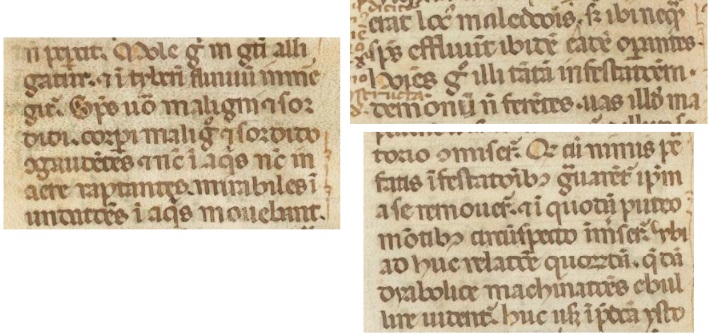

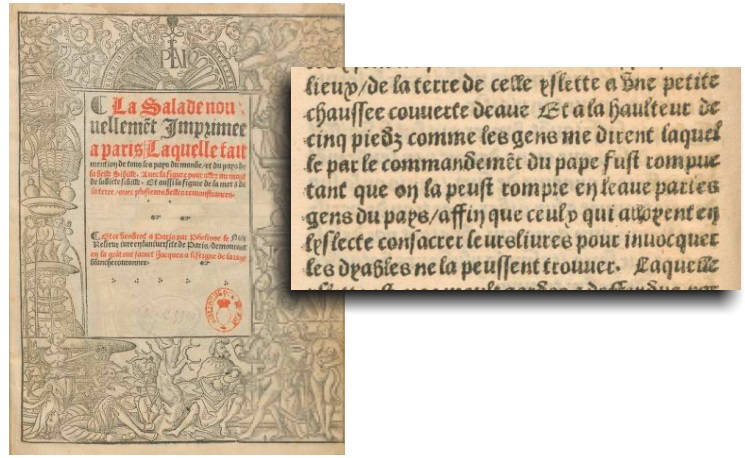



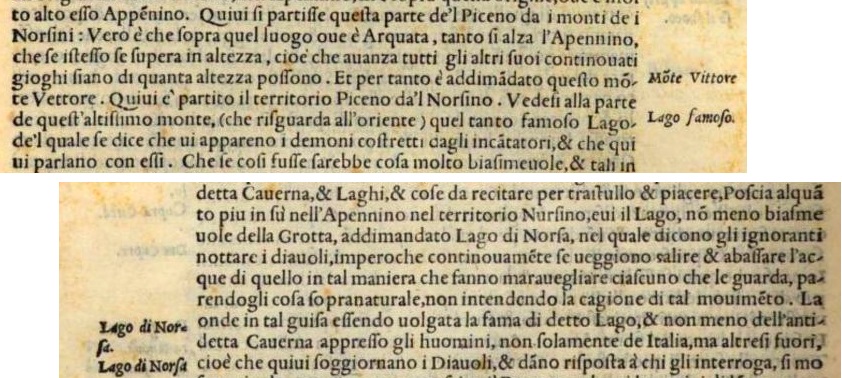



14 Nov 2019
Sibillini Mountain Range, the legend before the legends /3. Necromancy as a shared feature - 3.3 The common role of necromancy in the two legends
After this initial phase of our analysis on the common traits which mark the legends of the Sibyl's Cave and the Lakes of Pilate, we have reached a first significant conclusion: in both legends, necromancy plays a major role.
Actually necromancy, intended as the staging of magical rituals for the summoning of evil entities so as to demand forbidden services, has been carried out at both sites throughout many centuries.
In the previous paragraphs, we noted that evil-minded people have been visiting the Lake set within the crests of Mount Vettore (Fig. 1) for hundreds of years, with no interest at all in the story of Pontius Pilate, a foreign narrative which just covered and embellished the true local tale: an original tradition concerning consecration of spellbooks and the staging of impious rituals to be carried out after having duly conjured up some sort of legendary fiendish entities. This tale was known since the first half of the fourteenth century, and we already demonstrated, in our previous paper “A legend for a Roman prefect: the Lakes of Pontius Pilate”, that Pilate was just an extraneous superposition to a local myth, which was already present at the site.
We also noted that the same sort of malevolent people used to visit the Sibyl's Cave, set on the peak of Mount Sibyl (Fig. 2), a few miles away from the Lake, to perform the same kind of forbidden rituals. Necromancers were not coming to the Cave in search of a Queen Sibyl and her magnificent court, in which love and eternal joy and perdition of one's soul could be experienced: they looked for magical mights instead, to be summoned and enslaved so as to fulfill one's evil wishes. They looked for power, and paid no heed to the chivalric story of an Apennine Sibyl, another extraneous tale which came from far-away countries, a narrative concerning Morgan le Fay and her fairy mate Sebile, with their apparel of emprisoned knights, hidden castles and magical mountains, popular themes in the romances and poems belonging to the Matter of Britain, in which both are depicted as powerful enchantresses and necromancers: an ascendancy we already traced in our previous paper “Birth of a Sibyl: the medieval connection”.
So necromancy is one of the common aspects which mark both legendary tales, the Lake's and Cave's. A common aspect which is also mentioned by a fifteenth-century Pope, Pius II Piccolomini, who, in his most famous letter, written on January, 15th 1444 to his cousin and friend Gregorio Lolli (which we already presented in our previous article “Pope Pius II Piccolomini's original letter on the Sibyl's cave published for the first time ever”), so depicts both sites without discriminating between them as to the necromantic rituals being carried out at the two places:
«In discussing the subject, it came to my mind that there is a place, in Umbria - which is known as the province of the Duchy - not far from the town of Norcia, where a craggy mountain opens into a huge cavern, through which running waters flow. I remember I once heard that witches are found there and fiends and nocturnal wraiths; there those who house a bold heart can hear the voices of fiendish spirits, and talk to them and learn from them the magical arts. [...] he once mentioned to me the name of the lake and also provided a description of the place».
[In the original Latin text: «Inter conferendum autem venit in mentem locum esse in umbria, quae provincia ducatus dicitur, non longe ab Urbe Nursia ubi preruptus mons ingentem speluncam facit per quam aquae fluunt. Illic memini audisse me striges esse et Demones ac nocturnas umbras, ubi qui audaces animo sunt, spiritus nequam audiunt, alloquunturque et artes ediscunt magicas. [...] haec mihi vera esse asseveravit lacum nominavit et locum descripsit»].
In Piccolomini's text, the Lake and Cave are considered as belonging to a same sinister setting, in which summoning is performed, and entities conjured up.
Thus, certainly necromancy is one of the marking traits of the two legendary sites which are located in the Sibillini Mountain Range, in Italy.
Are there further traits that mark both places, the Sibyl's Cave and the Lakes of Pilate? Yes, there are. And we have just started meeting them when discussing necromancy.
Because necromancy just summons some malevolent thing. Mythical evil presences are conjured up. We are now about to confront with the fiendish entities that, according to the legendary tales, haunt both the Cave and Lake.
Monti Sibillini: la leggenda prima delle leggende /3. La negromanzia come elemento comune - 3.3 Il ruolo condiviso della negromanzia in entrambe le leggende
A valle di questa fase iniziale della nostra analisi relativa agli aspetti comuni che marcano sia la leggenda della Grotta della Sibilla che il mito dei Laghi di Pilato, abbiamo raggiunto una prima interessante conclusione: in entrambe le leggende, la negromanzia gioca un ruolo primario.
È un fatto che l'arte negromantica, da intendersi come l'effettuazione di magici rituali finalizzati all'evocazione di entità maligne, dalle quali tentare di ottenere proibiti servigi, è stata effettivamente praticata in entrambi i siti, e attraverso molti secoli.
Nei paragrafi precedenti, abbiamo potuto notare come personaggi ben poco raccomandabili siano stati soliti recarsi in visita a quel Lago annidato tra le creste del Monte Vettore (Fig. 1) per centinaia di anni, senza manifestare alcun interesse per la leggenda di Ponzio Pilato, una narrazione estranea ai luoghi che si limitava a coprire e romanzare il vero mito originario: una tradizione nativa, quest'ultima, concernente la consacrazione di libri magici e la messa in scena di empi rituali da compiersi dopo avere debitamente evocato una qualche sorta di leggendaria entità maligna. Questo racconto era già noto nella prima metà del quattordicesimo secolo, e abbiamo già avuto modo di dimostrare, nel nostro precedente articolo, "Una leggenda per un prefetto romano: i Laghi di Ponzio Pilato", come Pilato costituisse una mera sovrapposizione narrativa, originatasi in luoghi lontani, che velava un mito locale, già caratterizzante quel sito.
Abbiamo anche potuto notare come lo stesso genere di malintenzionati personaggi usasse recarsi in visita presso la Grotta della Sibilla, posta sulla cima dell'omonimo monte (Fig. 2), distante pochi chilometri dal Lago, per eseguire la stessa tipologia di rituali proibiti. Quei negromanti non andavano alla Grotta in cerca di una Regina Sibilla e della sua magnifica corte, presso la quale ricercare amore e gioia eterna e perdizione della propria anima: essi erano, invece, alla ricerca di magici poteri, da evocare e porre al proprio servizio in modo da realizzare i propri malvagi desideri. Inseguivano il potere, e non erano affatto interessati alla cavalleresca storia di una Sibilla Appenninica, un altro racconto estraneo che giungeva da contrade lontane, una narrazione relativa a Morgana e alla sua fatata compagna Sebile, con il loro apparato costituito da cavalieri imprigionati, castelli nascosti e magiche montagne, assai popolari nei romanzi e nei poemi appartenenti alla Materia di Bretagna, nella quale entrambe sono descritte come potenti incantatrici e negromanti: un'ascendenza che abbiamo già avuto modo di tracciare nel nostro precedente articolo "Nascita di una Sibilla: la traccia medievale".
E dunque, la negromanzia costituisce uno dei tratti comuni che caratterizzano entrambi i racconti leggendari, quello del Lago e quello della Grotta. Un aspetto condiviso che è anche menzionato da un Papa vissuto nel quindicesimo secolo, Pio II Piccolomini, il quale, nella sua famosissima lettera, scritta il 15 gennaio 1444 all'amico e cugino Gregorio Lolli (già da noi presentata nel precedente articolo “La lettera originale di Papa Pio II Piccolomini sulla grotta della Sibilla pubblicata oggi per la prima volta”), descrive in questo modo entrambi i siti, senza porre alcun discrimine tra i due per quanto riguarda i rituali negromantici effettuati in quei luoghi:
«Mentre parlavamo, mi venne in mente che esiste un lago, in Umbria, detta anche provincia del Ducato, non lontano dalla città di Norcia, dove un'impervia montagna ospita una immane caverna, attraverso la quale scorrono le acque. Mi ricordo di aver sentito dire che lì si trovano streghe e demoni e ombre notturne, un luogo nel quale coloro che posseggono un animo audace possono ascoltare le voci degli spiriti malvagi, parlare con loro e apprendere le arti magiche. [...] mi assicurò che tutte queste cose sono vere, mi fece menzione del lago e mi descrisse il luogo».
[Nel testo originale latino: «Inter conferendum autem venit in mentem locum esse in umbria, quae provincia ducatus dicitur, non longe ab Urbe Nursia ubi preruptus mons ingentem speluncam facit per quam aquae fluunt. Illic memini audisse me striges esse et Demones ac nocturnas umbras, ubi qui audaces animo sunt, spiritus nequam audiunt, alloquunturque et artes ediscunt magicas. [...] haec mihi vera esse asseveravit lacum nominavit et locum descripsit»].
Nel testo del Piccolomini, il Lago e la Grotta sono considerati come appartenenti a un medesimo sinistro contesto, presso il quale evocazioni vengono praticate, e entità richiamate.
Quindi, appare indubbio come la negromanzia costituisca uno dei tratti caratterizzanti entrambi i siti leggendari, ambedue collocati tra i Monti Sibillini, in Italia.
È possibile rilevare ulteriori aspetti che caratterizzino entrambi i siti, la Grotta della Sibilla e i Laghi di Pilato? Certo, ve ne sono anche altri. E abbiamo proprio cominciato a menzionarli quando abbiamo iniziato a occuparci di negromanzia.
Perché negromanzia significa evocare qualcosa. Maligne presenze mitiche vengono richiamate. Stiamo ora per confrontarci con le demoniache entità che, secondo i leggendari racconti, abiterebbero sia la Caverna che il Lago.
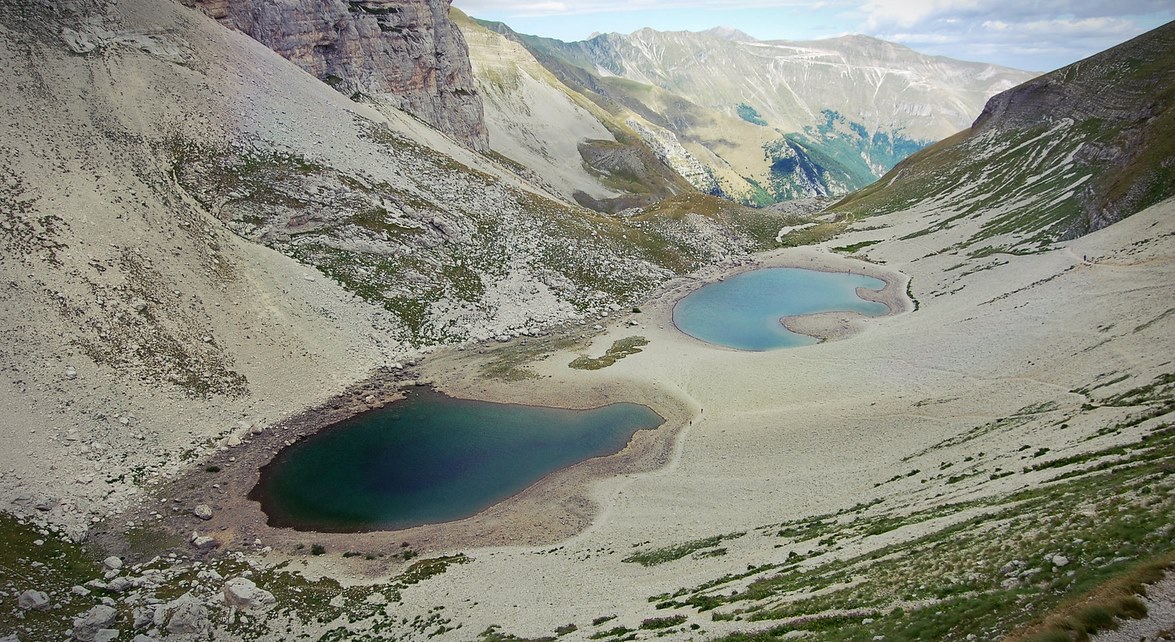

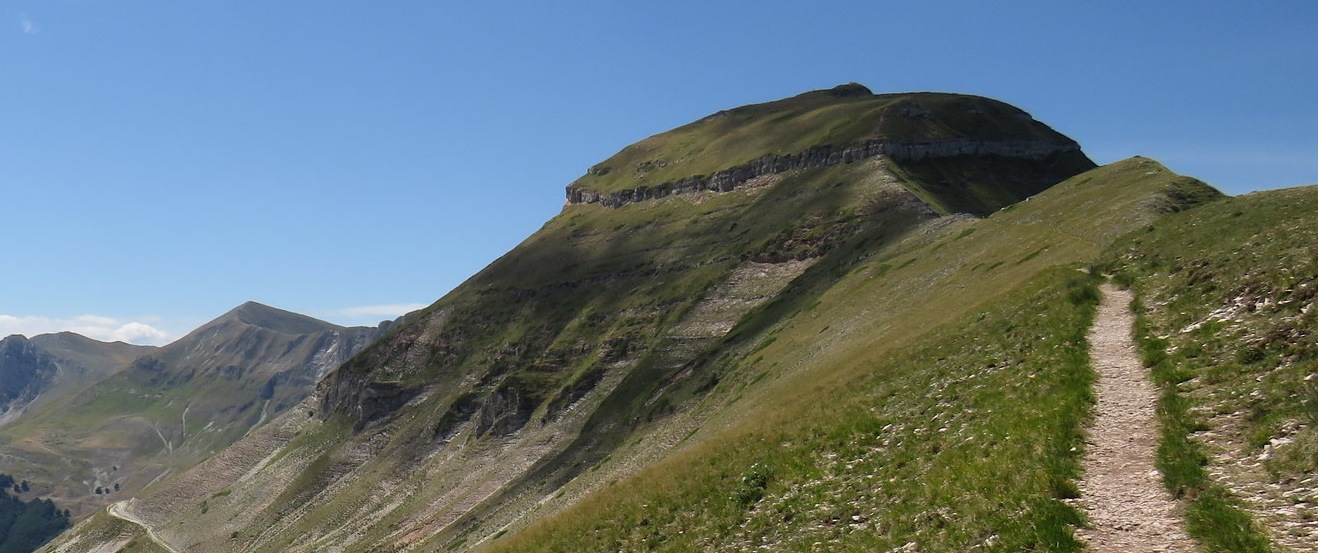

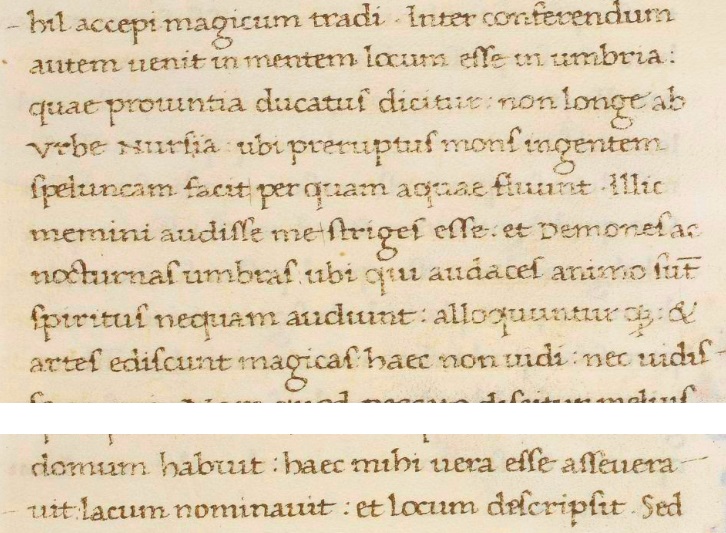

12 Nov 2019
Sibillini Mountain Range, the legend before the legends /3. Necromancy as a shared feature - 3.2 Conjurations at the Cave's entrance
We saw that necromantic rituals are an integral part of the legendary tale concerning the Lakes of Pilate. Can we state the same as to the Cave named after the Apennine Sibyl?
Apparently, the Sibyl's Cave shows no direct, original link to forbidden, necromantic arts, even though the place is obvioulsy connected to powerful magic being practised within its gloomy recesses. It is Andrea da Barberino, in his fifteenth-century romance “Guerrino the Wretch”, who narrates of the loathsome transformations of the inhabitants of the cave, who every saturday and sunday are turned into serpents, dragons, toads, worms and other abominable animals: a sign of a mighty magical power at work in the cave (Fig. 1). And the same account is reported by Antoine de la Sale in “The Paradise of Queen Sibyl”, in which he offers the reader a similar scene of ghastly transmutations occurring in the cavern (Fig. 2).
Neither Andrea da Barberino nor Antoine de la Sale include in their respective works any straight description of magical rituals being performed by visitors in the cave or by its entrance. Nonetheless, necromancy and necromancers are set at the very foundation of the legend of the Sibyl's cave, as we already proved in our previous paper “Birth of a Sibyl: the medieval connection”, in which the ascendancy of the Apennine Sibyl is to be traced back to Sebile, the skilled fairy and necromancer who is presented as a mate of, and alter-ego to, Morgan le Fay, King Arthur's half-sister in the legendary cycle of the Matter of Britain, with Morgan being compared to a Sibyl, possibly the Cumaean, as to their unprecedented necromantic powers in the German poem “Erec”, written by Hartmann von Aue in 1185 (Fig. 3):
«If she wanted, she could turn someone into a bird or animal. After that she could quickly give him his usual shape. She knew all sorts of magic arts. She lived much against God: for under her command were the birds of the wild, of forests and fields, and what is most important to me, the evil spirits, which are called demons, were all under her control. [...] Since the Sybil died, and Ericto perished, of which Lucanus tells us, and sorcery which they could command had died away ages ago, with her it all came back (about which I don't want to say much at this time, since it would take too long). Since then, the earthly realm probably has had no better mistress of the magic arts than Morgan le Fay»
[In the original Old German text: «vnd ſo ſy des began - ſo mochte ſy den man - Ze vogel oder ze tiere - darnach gab ſy im ſchiere - wider ſein geſchafft - ſÿ kunde doch zaubers die kraft - sÿ lebete vaſt wider got - wann es wartette jr gepot - das gefugl zu dem wilde - on walde vnd on geuilde - vnd daz mich daz maiſte - die vbeln geiſte - die da tiefln ſint genant - die waren alle vnnder jr handt [...] Seyt daz ſibilla erſtarb - vnd Ericto verdarb - von der vns Lucanuſ zalt - daz jr zauberlich gewalt - wem ſÿ wolte gepot - der dauor was lanng todt - daz er erſtund wol geſunt - von der ich euch hie zeſtund - nu nicht mer fagen wil - wann es wurde ze vil - sy gewan das erdtrich - das wiſſet warlich - von zauberlichen ſÿnne - nie beſſer maiſterÿnne - dann Famurgan»].
Such is the necromantic lineage of Sibyl - Sebile - Morgan as investigated in our preceding research papers. And, tough not addressed directly by Andrea da Barberino and Antoine de la Sale, necromancy is fully part of the legendary heritage of the Sibyl's Cave, as we can spot in subsequent authors.
In his “General description of Italy”, the same Leandro Alberti we quoted from when addressing the Lakes of Pilate provides us with a significant hint to the magical benefits that might arise from a visit to the Sibyl (Fig. 4):
«The huge, frightful, ghastly hollow which was named after the Sibyl: about which a popular lore (or rather a foolish rumour) maintains [... that] those who were there and then succeeded in coming out from would be endowed by the Sibyl with so many advantages that they subsequently live their life in sheer happiness»
[In the original Italian text: «La larga, horrenda et spaventevole spelunca nominata Caverna della Sibilla. De la quale è volgata fama, anzi pazzesca favola [... che] quelli che vi erano stati et poi ritornarano fuori, gli sono fatte tante gratie et privileggi, da la Sibilla, che felicissimamente poi passano i suoi giorni»].
According to her legendary renown, the Apennine Sibyl, when duly addressed and served, may bestow great gifts. But is all that achieved by some kind of necromantic ritual?
The answer is yes. And we find a full illustration of that in the work written by Pierre Crespet, also known as 'Crespetus', a French Celestinian monk who lived in the second half of the sixteenth century. More than one hundred fifty years after “Guerrino the Wretch” and “The Paradise of Queen Sibyl”, Crespetus explains the necromantic arts that are to be played not at the Lakes of Pilate, but directly at the Sibyl's cave (Fig. 5):
«A renowned magician whose name was Domenico Mirabelli [...] and his stepmother Marguerite Garnier, who were arrested in Mantua with their spellbooks that they were fetching to the Sibyls, the goddesses of sorcerers, to consecrate them so as to render their books more powerful [...] he went to take advice from the renowned Sibyl about whom the travellers to Italy maintain she is to be found in a cave near the town of Norcia in Italy [...] the Sibyl gave to him a consecrated book, and into a ring he had on his finger she put a spirit; by means of these book and spirit he would be able to travel any place he wished to be transferred to, provided the wind was not blowing against him».
[In the original French text: «Un insigne magicien nommé Dominique Mirabille Italien [...] & à sa belle mere Marguerite Garnier, qui furent apprehendez à Mante avec leur livres de magie qu'ils portoient aux Sibylles deesses des magiciens pour etre consacrez, à fin d'avoir plus d'effet [...] il avoit esté consulter la Sibylle fameuse que les voyageurs d'Italie asseurent etre en une grotte ou carriere proche de la ville de Nurse en Italie [...] laquelle luy donna un livre consacré, & luy meit dans un agneau qu'il avoit au doigt un esprit, par le moyen desquels livre & esprit il eust la puissance d'aller en tous lieux où il souhaittoit estre transporté moyenant que le vent ne fust contraire.»]
The above words are taken from Crespetus' “De la hayne de Satan et malins esprist contro l'homme” (Livre I, Discours 6), published in Paris in 1590. Further details on the necromantic rituals to be performed at the Sibyl's cave are provided later in the same text (Discours 15) (Fig. 6):
«Circles are traced so that the Fiend is not allowed to enter them or hurl himself on those who summon him; they are made safe by bearing crosses and other holy tokens from which the Fiend recoils».
[In the original French text: «Les cercles se font, afin que le diable n'ait entree ou force sur ceux qui l'invoquent & appellent à leur secours, & sont munis de croix & autres expiations que le diable redoubte»].
Thus, just like the Lakes of Pilate, the Sibyl's Cave was the stage for magical, necromantic rites. The aim was to win for themselves fame and earthly richies, to be obtained through the favour and action of evil entities, as Crespetus explains:
«In the plea that was found on them addressed to the Sibyls who presided over Necromancy and Magic arts, the following requests were included, that they besought the Sibyls to consecrate their books so that the evil spirits shall fulfill their commanding spells without any harm for them, that they shall become visible in the form of a handsome man [...] and ready to appear at day or night, whenever conjured up. They also asked the Sibyls to mark their spellbooks, which were three in number, with their power, so that they would be able to summon the above spirits, and prevent any arrest by the Justice, and be lucky in all and every business, well received by Kings, Princes and Lords, always winners in games, and able to gather a rich wealth, at the same time scorning any unfriendly attack».
[In the original French text: «Car en la requeste qu'on leur trouva pour presenter au Sibylles qui president sur la Necromance, & Magie, ces choses estoient contenues, qu'ils supplioient les Sibylles de consacrer leur livres à tels effects que les mauvais esprits fissent tout ce que leur seroit enjoint par leur coniuration sans faire aucun mal, apparoissans en forme de bel homme, & qu'on ne fust contrainst de faire aucun cercle n'y en leurs maisons, ny aux champs, & qu'ils fussent prompts à venir de nuist & de jour, quand ils seroient evoquez. Les supplioient aussi d'apposer à leurs dits livres de Magie, qui estoient trois en nombre, leur caractere, afin qu'ils eussent plus de puissance pour appeller lesdits esprits, & qu'ils ne fussent repris de Iustice, ains qu'ils fussent fortunez en toutes leurs entreprises, bien aymez des Roys Princes, & grands Seigneurs, ne perdissent jamais aux jeux, ains fussent chanceux & gaignassent quand ils voudroient, que leurs ennemis ne pourtassent nuysance»].
In this framework, the Sibyl's Cave is not considered as the entryway to a hidden, subterranean realm inhabited by handsome damsels and a fairy queen, ready to bestow blissfulness and a ceaseless life of sin on daring visitors.
In this case, the Cave appears to be something very different. It is a place where necromancy is carried out, to consecrate spellbooks and win for oneself forbidden advantages. A legendary fame, unreasonable and mythical as it certainly is; and yet it reminds us of another place, not far from this gloomy cavern.
It brings to our mind the Lakes of Pilate. Only a few miles away.
Monti Sibillini: la leggenda prima delle leggende /3. La negromanzia come elemento comune - 3.2 Evocazioni all'ingresso della Grotta
Abbiamo visto come i rituali negromantici costituiscano parte integrante del racconto leggendario che concerne i Laghi di Pilato. Possiamo affermare lo stesso anche in relazione alla Grotta il cui nome è legato a quello della Sibilla Appenninica?
Apparentemente, la Grotta della Sibilla sembrerebbe non mostrare alcuna connessione, diretta e originaria, con la pratica di arti proibite e negromantiche, anche se il luogo si presenta, ovviamente, come fortemente caratterizzato dalla potente magia praticata all'intero dei suoi tenebrosi recessi. È lo stesso Andrea da Barberino, nel suo quattrocentesco romanzo "Guerrin Meschino", a narrarci delle repellenti trasformazioni degli abitanti della Grotta, i quali ogni sabato e domenica vengono tramutati in serpenti, draghi, rospi, vermi e altre abominevoli creature: un segno delle incontenibili forze magiche all'opera nella caverna (Fig. 1). E lo stesso racconto ci viene proposto anche da Antoine de la Sale nel suo "Il Paradiso della Regina Sibilla", nel quale egli propone al lettore un'analoga scena a proposito delle orribili trasformazioni che si verificano nella caverna (Fig. 2).
Ma né Andrea da Barberino, né Antoine de la Sale inseriscono nelle loro rispettive opere alcuna diretta rappresentazione di rituali magici eseguiti nella Grotta, o presso l'ingresso della medesima, da alcun personaggio in visita. Nondimeno, la negromanzia e i negromanti si collocano alla stessa base della leggenda della Grotta della Sibilla, come abbiamo già avuto modo di dimostrare nel nostro precedente articolo "Nascita di una Sibilla: la traccia medievale", in cui l'ascendenza della Sibilla Appenninica può essere rintracciata, indietro nel tempo, fino a Sebile, l'esperta fata e negromante presentata come compagna e alter ego di Morgana la Fata, la sorellastra di Re Artù nel leggendario ciclo della Materia di Bretagna. In quel contesto, Morgana viene paragonata a una Sibilla, da intendersi probabilmente come la Cumana, in relazione agli straordinari poteri negromantici posseduti da entrambe, nell'antico poema tedesco "Erec", scritto da Hartmann von Aue nel 1185 (Fig. 3):
«Se lo avesse voluto, avrebbe potuto trasformare chiunque in un uccello o in un animale. E poi gli avrebbe rapidamente restituito la sua forma usuale. Conosceva ogni sorta di arti magiche. Essa viveva marcatamente contro Dio: perché sotto il suo comando erano gli uccelli delle terre disabitate, dei boschi e dei campi, e ciò che è più importante per me, gli spiriti maligni, che sono chiamati dèmoni, erano sotto il suo controllo. [...] Da quando la Sibilla è morta, e Erichto è perita, della quale Lucano ci parlò, e le arti magiche che esse potevano comandare sono sparite ormai da tanto tempo, con essa sono pienamente ritornate (ma di questo non voglio raccontare troppo ora, perché troppo tempo occorrerebbe). Da quell'epoca, sulla terra non c'è stata forse alcuna altra signora delle arti magiche se non Morgana la Fata»
[Nel testo originale in antico tedesco: «vnd ſo ſy des began - ſo mochte ſy den man - Ze vogel oder ze tiere - darnach gab ſy im ſchiere - wider ſein geſchafft - ſÿ kunde doch zaubers die kraft - sÿ lebete vaſt wider got - wann es wartette jr gepot - das gefugl zu dem wilde - on walde vnd on geuilde - vnd daz mich daz maiſte - die vbeln geiſte - die da tiefln ſint genant - die waren alle vnnder jr handt [...] Seyt daz ſibilla erſtarb - vnd Ericto verdarb - von der vns Lucanuſ zalt - daz jr zauberlich gewalt - wem ſÿ wolte gepot - der dauor was lanng todt - daz er erſtund wol geſunt - von der ich euch hie zeſtund - nu nicht mer fagen wil - wann es wurde ze vil - sy gewan das erdtrich - das wiſſet warlich - von zauberlichen ſÿnne - nie beſſer maiſterÿnne - dann Famurgan»].
Tale è la negromantica discendenza di Sibilla - Sebile - Morgana, così come investigata nei nostri precedenti articoli di ricerca. E, benché tale discendenza non sia apertamente esplicitata da Andrea da Barberino e Antoine de la Sale, la negromanzia è pienamente parte dell'eredità leggendaria della Grotta della Sibilla, come possiamo chiaramente discernere negli autori successivi.
Nella sua "Descrittione di tutta l'Italia", è lo stesso Leandro Alberti, da noi già citato in relazione ai Laghi di Pilato, a fornirci un indizio assai significativo in merito ai magici vantaggi potenzialmente ottenibili visitando la Sibilla (Fig. 4):
«La larga, horrenda et spaventevole spelunca nominata Caverna della Sibilla. De la quale è volgata fama, anzi pazzesca favola [... che] quelli che vi erano stati et poi ritornarano fuori, gli sono fatte tante gratie et privileggi, da la Sibilla, che felicissimamente poi passano i suoi giorni».
Secondo questa fama leggendaria, la Sibilla Appenninica, se debitamente consultata e servita, avrebbe potuto onorare il visitatore con molti doni. Ma per ottenere tutto ciò sarebbe stato forse necessario praticare rituali tipicamente negromantici?
La risposta è affermativa. E possiamo reperire una completa illustrazione di ciò nell'opera scritta da Pierre Crespet, conosciuto anche come 'Crespetus', un monaco celestiniano francese vissuto nella seconda metà del sedicesimo secolo. Più di centocinquanta anni dopo "Guerrin Meschino" e "Il Paradiso della Regina Sibilla", Crespeto ci rappresenta le pratiche negromantiche da eseguire non presso le rive dei Laghi di Pilato, ma direttamente alla Grotta della Sibilla (Fig. 5):
«Un famoso mago chiamato Domenico Mirabello [... e] la sua matrigna Marguerite Garnier, i quali furono entrambi arrestati a Mantova con i loro libri di magia, che essi stavano portando alle Sibille, divinità dei maghi, per essere consacrati, al fine di potenziarli [...] egli era stato a consultare la famosa Sibilla che i viaggiatori in Italia affermavano trovarsi in una grotta o cava in prossimità della città di Norcia in Italia [...] La Sibilla gli diede un libro consacrato, & mise in un anello che egli aveva al dito uno spirito, per mezzo dei quali libro e spirito egli avrebbe avuto il potere di recarsi in ogni luogo egli avesse desiderato di essere trasportato, a condizione che il vento non gli fosse contrario».
[Nel testo originale francese: «Un insigne magicien nommé Dominique Mirabille Italien [...] & à sa belle mere Marguerite Garnier, qui furent apprehendez à Mante avec leur livres de magie qu'ils portoient aux Sibylles deesses des magiciens pour etre consacrez, à fin d'avoir plus d'effet [...] il avoit esté consulter la Sibylle fameuse que les voyageurs d'Italie asseurent etre en une grotte ou carriere proche de la ville de Nurse en Italie [...] laquelle luy donna un livre consacré, & luy meit dans un agneau qu'il avoit au doigt un esprit, par le moyen desquels livre & esprit il eust la puissance d'aller en tous lieux où il souhaittoit estre transporté moyenant que le vent ne fust contraire.»]
Queste parole sono tratte dall'opera di Crespeto “De la hayne de Satan et malins esprist contro l'homme” (Libro I, Discorso 6), pubblicato a Parigi nel 1590. Ulteriori dettagli in merito ai rituali negromantici da effettuarsi presso la Grotta della Sibilla sono forniti più oltre nel medesimo testo (Discorso 15) (Fig. 6):
«I circoli sono tracciati affinché il demonio non entri in essi o si scagli contro coloro che l'invocano e lo chiamano in aiuto; essi sono muniti di croci e di altri sacri simboli che il diavolo teme».
[Nel testo originale francese: «Les cercles se font, afin que le diable n'ait entree ou force sur ceux qui l'invoquent & appellent à leur secours, & sont munis de croix & autres expiations que le diable redoubte»].
Dunque, proprio come ai Laghi di Pilato, la Grotta della Sibilla appare essere il teatro di riti magici e negromantici. L'obiettivo è quello di acquistare per se stessi fama e ricchezze terrene, da guadagnare a mezzo dei favori e delle azioni condotti da entità maligne, come racconta Crespeto:
«Nella richiesta che venne loro trovata indosso, da presentarsi alle Sibille che presiedevano alla Negromanzia e alla Magia, erano contenute queste cose, che essi supplicavano le Sibille di consacrare i loro libri in modo tale che gli spiriti maligni facessero tutto ciò che fosse loro ingiunto nel corso dell'evocazione senza loro nuocere, apparendo in piacevole forma di uomo [...] e che fossero pronti a venire di notte come di giorno, quando fossero stati evocati. Le supplicavano inoltre di apporre ai loro libri magici, che erano in numero di tre, il proprio marchio, affinché essi risultassero più potenti al fine di poter richiamare i detti spiriti, e che essi non fossero mai arrestati dalla Giustizia, e anche che risultassero favoriti in tutte le loro imprese, amati sommamente da Re, Principi e grandi Signori, che non perdessero mai ai giochi d'azzardo, e potessero anche godere della fortuna e guadagnare quanto volessero, sviando al contempo gli attacchi dei propri nemici».
[Nel testo originale francese: «Car en la requeste qu'on leur trouva pour presenter au Sibylles qui president sur la Necromance, & Magie, ces choses estoient contenues, qu'ils supplioient les Sibylles de consacrer leur livres à tels effects que les mauvais esprits fissent tout ce que leur seroit enjoint par leur coniuration sans faire aucun mal, apparoissans en forme de bel homme, & qu'on ne fust contrainst de faire aucun cercle n'y en leurs maisons, ny aux champs, & qu'ils fussent prompts à venir de nuist & de jour, quand ils seroient evoquez. Les supplioient aussi d'apposer à leurs dits livres de Magie, qui estoient trois en nombre, leur caractere, afin qu'ils eussent plus de puissance pour appeller lesdits esprits, & qu'ils ne fussent repris de Iustice, ains qu'ils fussent fortunez en toutes leurs entreprises, bien aymez des Roys Princes, & grands Seigneurs, ne perdissent jamais aux jeux, ains fussent chanceux & gaignassent quand ils voudroient, que leurs ennemis ne pourtassent nuysance»].
In questo contesto, la Grotta della Sibilla non è affatto presentata come l'ingresso a un nascosto regno sotterraneo abitato da graziose damigelle e da una fatata regina, pronta a elargire amorose gioie e una vita senza fine ai più arditi visitatori.
La Grotta ci appare, invece, in una veste del tutto differente. Si tratta di un luogo dove viene praticata la negromanzia, per consacrare libri magici e ottenere proibiti vantaggi. Una fama leggendaria, irragionevole e del tutto mitica come certamente è, ma che comunque ci ricorda un altro luogo, che si trova non molto distante da questa tenebrosa caverna.
Ci riporta alla mente i Laghi di Pilato. Solamente a pochi chilometri di distanza.
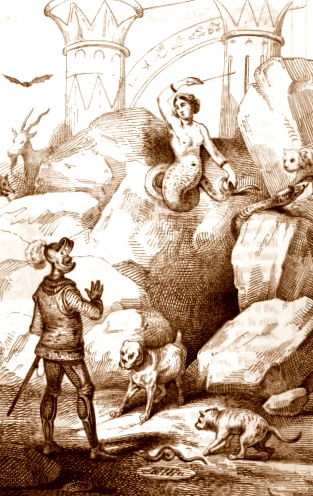

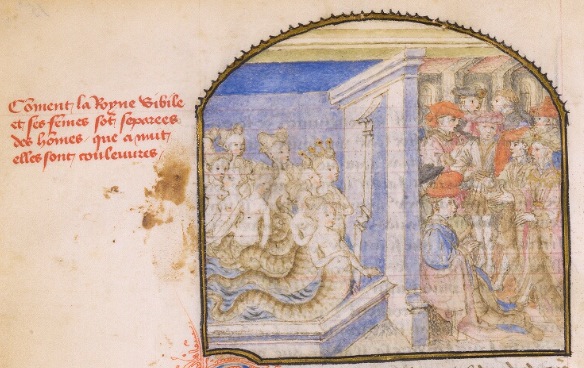

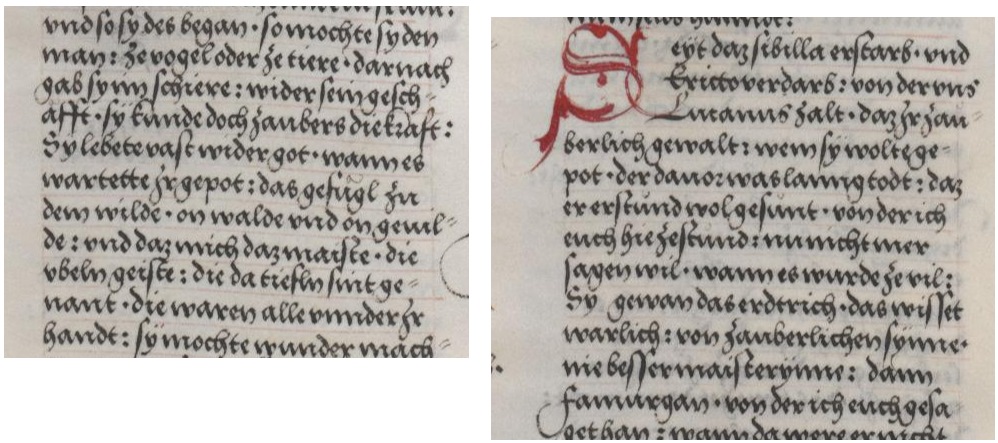

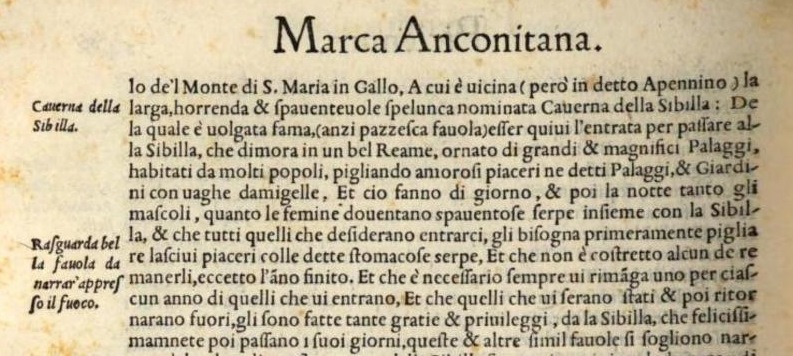

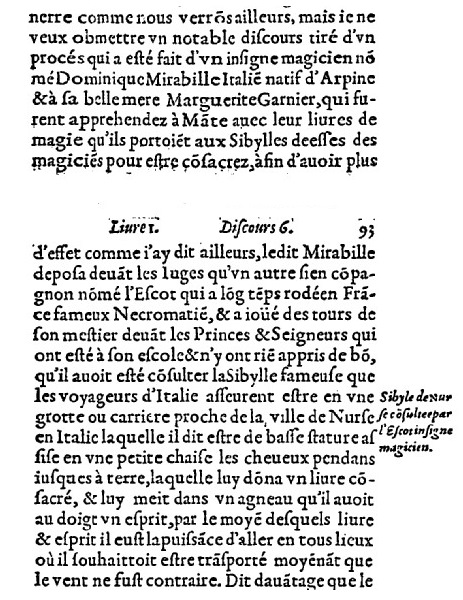

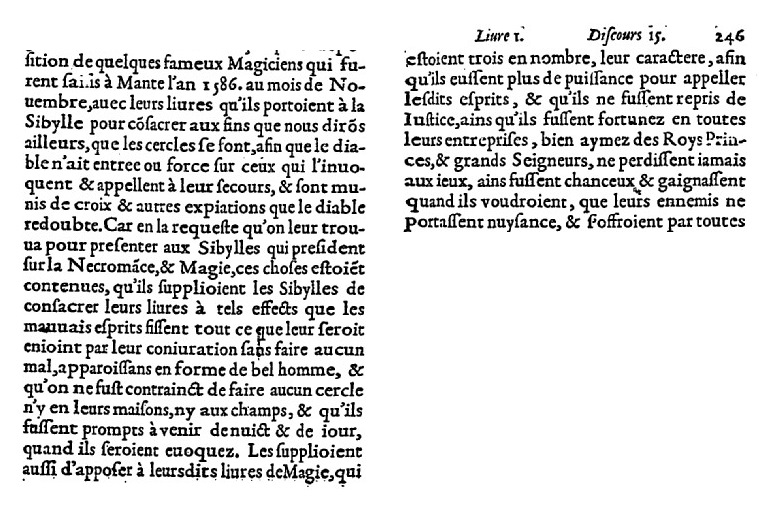

10 Nov 2019
Sibillini Mountain Range, the legend before the legends /3. Necromancy as a shared feature - 3.1 Necromantic rituals by the icy waters
The first common aspect we are going to address is a well-known one. Both places, the Lake and the Cave, are marked by necromancy.
For centuries, people have been visiting the two sites to celebrate magic rituals in them or by their side, with the specific purpose to address legendary otherwordly entities and reach some purpose and/or get forbidden knowledge. A mere illusion, of course: a fallacious and legendary credence, an irrational belief, yet assigned enough credit to attract self-styled wizards and necromancers as far as this remote places, hidden within the cliffs of the Sibillini Mountain Range.
This aspect is most easily detected when we confront with the legendary renown which has enshrouded the Lake of Pilate since the early references provided by Antoine de la Sale in his fifteenth-century “The Paradise of Queen Sibyl” (Fig. 1):
«In the middle there is a small islet made of one boulder which was once walled all around, and the lower portion of this wall is still extant in many points. From the shore to the small island there is a narrow walkway submerged by the water which is five feet high as people told me; that passage was broken down by the local residents so as to make it impracticable, so that those who reached the island to consecrate their books by the art of necromancy wouldn't be able to find it anymore. That island is strictly guarded and protected from the local people on the ground that when anybody comes to it covertly and performs the art of the Fiend...».
[In the original French text: «Au milieu a une petite islete dun rochier qui jadis fut muree tout en tour encores y sont les fondemens du mur en plusieurs lieux. De la terre à celle isle a une petite chausse couverte deaue a la haulteur de v piez comme les gens me dirent laquelle fust rompue tant quon ne la peust cuier par les gens du pais affin que ceulz qui aloient en lisle consacrer leurs livres pour lart dingromance ne la peussent trouver. La quelle isle est moult gardee et deffendue des gens du pais pource que quant aucun y vient seleement et a fait son art de l'ennemy...»].
Thus, the Lake of Pilate was a place of choice to perform magical, forbidden arts. And would-be necromancers often met their own doom by the icy waters of the lake, as Antoine de la Sale himself reports (Fig. 2):
«Not much time has elapsed since two men were caught, one of them being a priest. The priest was brought to the said town of Norcia and there was martyred and burnt. The other was slaughtered into pieces and then thrown into the lake from the very people who had caught them both».
[In the original French text: «Navoit pas long temps quel y fut prins deux hommes dont lun estoit prestre ce preste fut admene a la dicte cite de norce et la fut martire et ars. Lautre fut taille a pieces et puis boute dedens le lac par ceulz qui les avoient prins»].
In 1474 the Italian scholar Flavio Biondo published his “De Italia illustrata” (“Italy illustrated”), subsequently translated into Italian in 1542, in which he provided a further reference to the magical arts performed at the Lake (Fig. 3):
«Further above, in the territory of Norcia, there is that renowned lake where according to false rumours the waters would be replete of evil spirits rather than fish; and the fame of [...] the lake has attracted a great number of lunatics committed to such foolish thing as necromancy, in search of knowledge and understanding of those sorcerous teachings; and a lot more in past centuries, as is reported, they were lured up to those lofty, imposing mountains, with great exertion, and utterly in vain».
[In the original Italian text: «Poco più su è quel lago famoso nel territorio di Norcia, dove dicono falsamente, che in vece di pesci, è pieno di demoni, e la fama [...] del lago ha ne di nostri tirati molti pazzi dati a queste poltronarìe de la negromantia, et avidi di sapere et intendere di queste novelle magiche, e più ne secoli passati, come si raggiona, gli ha tirati dico a sallire su questi altissimi monti, et alpestri, con gran fatica, e vana»].
Between 1496 and 1499, the German knight Arnold von Harff carried out a journey across many countries, which he described in his “Pilgrimage”, a travel account. In it he portrayed, once more, the necromantic character of the Lake set within the Sibillini Mountain Range (Fig. 4):
«After midday he [the lord of the place] rode with us up the mountain to where was a little lake. By this lake was a little chapel like a holy house, in which was a small altar. He told us that in former times, when the art of necromancy was abroad in the world, certain persons frequented this altar [...], performing their necromancy there. [...] When the people could not suffer this no longer, they made complaint to the castellan of this castle, who thereupon set up gallows between the holy house and the lake, and forbade that anyone should thenceforth exercise necromancy at the altar, and that any who did so should be hanged on the gallows».
[In the original German text: «Nae myttaghe reyt he mit vns oeuen off desen berch. Daer off stund eyn kleyne staynde see. By deser see stunt eyn kleyn cappelgen wie eyn heyligen huyss. Dae inne stunt eyn kleyn altair. Dae van saicht he vns, dat vurtzijden doe die kunst der nigermancien in der werlt vmb gynck, doe lieffen dese seluigen off desen altair [...], drijuende dae yere nigremancie. [...] Item dit en wolde dat volck nyet me lijden ind claget dem castelangen dys sloss, der van stund an eyn vpgereckde galge leyss settzen tusschen dat heyligen huyssgen in die see ind dede verbieden dat niemans me off dem elter nigermancie doyn en suyldt, der aber dat dede den seuldt man an die galge hangen»].
We find additional mentions about the Lake as we proceed further through the centuries. In 1550 Leandro Alberti, a Dominican friar, wrote the following words in his “Descrittione di tutta l'Italia” (“A general description of Italy”) (Fig. 5):
«Then further high above in the Apennines, in the land of Norcia, there is the Lake [...] which is called the Lake of Norcia [...] a few men coming from a far-away country [...] came to this place to consecrate evil, fiendish books to the devil, so as to have their wicked whishes fulfilled, of riches, fame, pleasures and the like. [...] after drawing the Circle, and having marked the required characters with their impious rituals [...] so many necromacers used to come, up to those rugged, elevated mountains».
[In the original Italian text: «Poscia alquanto più in su nell'Apennino nel territorio Nursino, evi il Lago [...] addimandato Lago di Norsa [...] alcuni huomini di lontano paese [...] venero a questi luoghi per consagrare libri scelerati et malvaggi al diavolo, per potere ottenere alcuni suoi biasimevoli desiderii, cioè di ricchezze, di honori, di amenosi piaceri et di simili cose. [...] havendo disegnato il Circolo, et fatti i debiti caratteri colle escomunicate cerimonie [...] tanto concorso di incantatori, che salivano sopra questi asperi et alti monti»].
How old is such necromantic renown? We can go back through the centuries and open the pages of the “Dittamondo”, a poem written between 1350 and 1367 by Fazio degli Uberti, a fourteenth-century poet from Tuscany. In this work we find the words written by the man of letter on the gloomy legend which already enshrouded the Lake in the second half of the fourteenth century (Fig. 6):
«I don't want to overlook the renown of the Mount of Pilate, where a lake is - which in summers is carefully guarded by watches on duty - because here Simon the Sorcerer ascends to consecrate his spellbook...».
[In the original Italian text: «la fama qui non vo’ rimagna nuda - del monte di pillato, dov’è il lago - che si guarda l'estate a muda a muda - però che qua s’intende in Simon mago - per sagrar il suo libro in su monta...»].
However, the most important reference concerning the Lake of Pilate is the most ancient that scholars have ever been able to retrieve. It is found in the “Reductorium Morale”, a work written by the French benedictine monk and abbot Petrus Berchorius (Pierre Bersuire), who lived between 1290 and 1362. In this passage, we find no mention of Pilate, yet we already meet with necromancers who attend the Lake's cold waters (Fig. 7):
«I heard a remarkable, horrific tale about Norcia, the Italian town, that was reported to me as an absolutely proven truth [...] amid the peaks which raise near that town there is a lake [...] today, no men but necromancers can get to the lake...».
[In the original Latin text: «Exemplum terribile esse circa Norciam Italie civitatem audivi pro vero et pro centies experto narrari [...] inter montes isti civitati proximos esse lacum [...] ad quem nullus hodie praeter necromanticos potest accedere...]».
So necromancers used to pay visits to the Lake set within the lofty crests of Mount Vettore well before his renown as a resting place for the Roman prefect Pontius Pilate was mentioned in the work written by Antoine de la Sale.
Therefore, it actually seems that necromancy represents an original trait of what we know today as the Lakes of Pilate: a fundamental point to start from if we want to understand the true origin of this legend, to which an additional myth relating to Pilate was subsequently added, as we illustrated in our previous paper “A legend for a Roman prefect: the Lakes of Pontius Pilate”.
Is this necromantic aspect also present in the legendary narrative concerning the Sibyl's cave?
Let's go ahead with our journey into the two legends. And we can anticipate that the answer will be fully positive.
Monti Sibillini: la leggenda prima delle leggende /3. La negromanzia come elemento comune - 3.1 Magici rituali presso gelide acque
Il primo tratto condiviso che andremo ad affrontare è assai noto. Entrambi i luoghi, il Lago e la Grotta, sono segnati dalla negromanzia.
Per secoli, i due siti sono stati oggetto di visite per celebrare riti magici in essi o nelle immediate vicinanze, con lo specifico obiettivo di entrare in contatto con leggendarie entità soprannaturali, al fine di ottenere un qualche effetto e/o acquisire proibite conoscenze. Una mera illusione, naturalmente: una credenza leggendaria e ingannevole, una convinzione irrazionale, eppure ritenuta così verosimile da attirare sedicenti maghi e negromanti fino a questi luoghi così remoti, nascosti tra le alte vette dei Monti Sibillini.
Questo aspetto si presenta ai nostri occhi in modo molto evidente nel momento in cui si prende in considerazione la fama leggendaria che ha avvolto il Lago di Pilato sin dagli antichi riferimenti resi disponibili da Antoine de la Sale nel suo quattrocentesco "Paradiso della Regina Sibilla" (Fig. 1):
«Nel mezzo si trova una piccola isoletta costituita da un'enorme roccia, che un tempo fu murata tutt'attorno, e in molti punti sono ancora visibili le parti inferiori di questo muro. Dalla riva a quest'isola corre un piccolo passaggio, sommerso nell'acqua profonda cinque piedi, così come la gente mi disse, il quale fu danneggiato dagli abitanti del luogo al fine di renderlo impraticabile, in modo che coloro che si recavano all'isola per consacrare i loro libri per arte di negromanzia non la potessero trovare più. Questa isola è molto sorvegliata e controllata dalla gente del luogo, perché quando qualcuno vi si reca in segreto per praticare l'arte del Nemico...».
[Nel testo originale francese:: «Au milieu a une petite islete dun rochier qui jadis fut muree tout en tour encores y sont les fondemens du mur en plusieurs lieux. De la terre à celle isle a une petite chausse couverte deaue a la haulteur de v piez comme les gens me dirent laquelle fust rompue tant quon ne la peust cuier par les gens du pais affin que ceulz qui aloient en lisle consacrer leurs livres pour lart dingromance ne la peussent trouver. La quelle isle est moult gardee et deffendue des gens du pais pource que quant aucun y vient seleement et a fait son art de l'ennemy...»].
Dunque, il Lago di Pilato costituiva un luogo d'elezione per l'esecuzione di arti magiche e proibite. E, spesso, quei sedicenti negromanti non facevano che andare incontro a un terribile destino personale, come lo stesso Antoine de la Sale ci riferisce (Fig. 2):
«Non è trascorso molto tempo da quando in quel luogo furono catturati due uomini, dei quali uno era un prete. Questo prete fu condotto nella detta città di Norcia e lì fu martirizzato e arso, L'altro fu smembrato e poi gettato nel lago da coloro che lo avevano catturato».
[Nel testo originale francese: «Navoit pas long temps quel y fut prins deux hommes dont lun estoit prestre ce preste fut admene a la dicte cite de norce et la fut martire et ars. Lautre fut taille a pieces et puis boute dedens le lac par ceulz qui les avoient prins»].
Nel 1474, lo studioso italiano Flavio Biondo pubblicò la sua opera "De Italia illustrata", in seguito tradotta in lingua italiana nel 1542, in cui egli riporta un'ulteriore menzione a proposito delle arti magiche praticate presso il Lago (Fig. 3):
«Poco più su è quel lago famoso nel territorio di Norcia, dove dicono falsamente, che in vece di pesci, è pieno di demoni, e la fama [...] del lago ha ne di nostri tirati molti pazzi dati a queste poltronarìe de la negromantia, et avidi di sapere et intendere di queste novelle magiche, e più ne secoli passati, come si raggiona, gli ha tirati dico a sallire su questi altissimi monti, et alpestri, con gran fatica, e vana».
Tra il 1496 e il 1499, il cavaliere tedesco Arnold von Harff intraprese un itinerario che lo condusse attraverso diversi paesi, da lui descritti nel suo "Pellegrinaggio", un resoconto di viaggio. Nella propria opera egli inserì un riferimento, ancora una volta, al carattere negromantico del Lago posto tra i Monti Sibillini (Fig. 4):
«Dopo mezzogiorno [il signore della contrada] cavalcò con noi sulla montagna, fino ad arrivare dove si trovava un piccolo lago. Accanto a questo lago si trovava una piccola cappella, simile a una santa casa. All'interno era posto un piccolo altare. Egli ci riferì che in passato, quando la negromanzia era praticata nel mondo, alcune persone frequentavano questo altare [...], praticando qui la loro negromanzia. [...] Non sopportando più tutto questo, la gente del luogo elevò delle proteste presso il signore di questo castello, che fece così innalzare una patibolo tra la santa casa e il lago, e proibì a chiunque, da allora in poi, di praticare la negromanzia presso l'altare, e che chiunque lo avesse fatto sarebbe stato impiccato su quella stessa forca».
[Nel testo originale tedesco: «Nae myttaghe reyt he mit vns oeuen off desen berch. Daer off stund eyn kleyne staynde see. By deser see stunt eyn kleyn cappelgen wie eyn heyligen huyss. Dae inne stunt eyn kleyn altair. Dae van saicht he vns, dat vurtzijden doe die kunst der nigermancien in der werlt vmb gynck, doe lieffen dese seluigen off desen altair [...], drijuende dae yere nigremancie. [...] Item dit en wolde dat volck nyet me lijden ind claget dem castelangen dys sloss, der van stund an eyn vpgereckde galge leyss settzen tusschen dat heyligen huyssgen in die see ind dede verbieden dat niemans me off dem elter nigermancie doyn en suyldt, der aber dat dede den seuldt man an die galge hangen»].
Ci imbattiamo in ulteriori riferimenti al Lago a mano a mano che procediamo oltre attraverso i secoli. Nel 1550 Leandro Alberti, un frate domenicano, scrive le seguenti parole nella sua "Descrittione di tutta l'Italia" (Fig. 5):
«Poscia alquanto più in su nell'Apennino nel territorio Nursino, evi il Lago [...] addimandato Lago di Norsa [...] alcuni huomini di lontano paese [...] venero a questi luoghi per consagrare libri scelerati et malvaggi al diavolo, per potere ottenere alcuni suoi biasimevoli desiderii, cioè di ricchezze, di honori, di amenosi piaceri et di simili cose. [...] havendo disegnato il Circolo, et fatti i debiti caratteri colle escomunicate cerimonie [...] tanto concorso di incantatori, che salivano sopra questi asperi et alti monti».
Ma quanto è antica questa negromantica fama? Possiamo ritornare indietro nei secoli e aprire le pagine del "Dittamondo", un poema redatto tra il 1350 e il 1367 da Fazio degli Uberti, poeta trecentesco originario della Toscana. Ecco le parole vergate da questo letterato a proposito della tenebrosa leggenda che già abitava quel Lago nella seconda metà del Trecento (Fig. 6):
«La fama qui non vo’ rimagna nuda - del monte di pillato, dov’è il lago - che si guarda l'estate a muda a muda - però che qua s’intende in Simon mago - per sagrar il suo libro in su monta...».
Ma il riferimento più importante concernente il Lago di Pilato è quello maggiormente risalente, il più antico che gli studiosi abbiano potuto reperire. Si trova nel "Reductorium Morale", un'opera scritta dal monaco e abate benedettino francese Petrus Berchorius (Pierre Bersuire), vissuto tra il 1290 e il 1362. In questo passaggio, non si rinviene alcuna menzione di Pilato, eppure già ci imbattiamo nei negromanti che si radunano presso le gelide acque del Lago (Fig. 7):
«Ho udito narrare un terribile racconto a proposito di Norcia, città d'Italia, riferitomi come cosa assolutamente vera e sicura [...] Tra le montagne che si innalzano in prossimità di questa città si trova un lago [...] al quale oggi nessun uomo, ad eccezione dei negromanti, può accedere...»
[Nel testo originale latino: «Exemplum terribile esse circa Norciam Italie civitatem audivi pro vero et pro centies experto narrari [...] inter montes isti civitati proximos esse lacum [...] ad quem nullus hodie praeter necromanticos potest accedere...].
E dunque maghi e negromanti erano soliti salire a quel Lago, posto tra le creste precipiti del Monte Vettore, ben prima che la fama di quelle acque come luogo di sepoltura del prefetto romano Ponzio Pilato fosse menzionata nell'opera di Antoine de la Sale.
Sembrerebbe, quindi, che l'aspetto negromantico rappresenti un tratto originario caratterizzante, sin da tempi molto antichi, ciò che oggi conosciamo come i Laghi di Pilato: un elemento fodamentale da cui partire se intendiamo comprendere la vera origine di questa leggenda, alla quale si è successivamente aggiunto un mito addizionale relativo a Ponzio Pilato, come abbiamo avuto modo di illustrare nel nostro precedente articolo "Una leggenda per un prefetto romano: i Laghi di Ponzio Pilato".
Questo tratto negromantico è forse presente anche nella leggendaria narrazione che riguarda la Grotta della Sibilla?
Per rispondere a questa domanda, proseguiamo con il nostro viaggio attraverso le due leggende. E possiamo già anticipare che la risposta sarà pienamente affermativa.
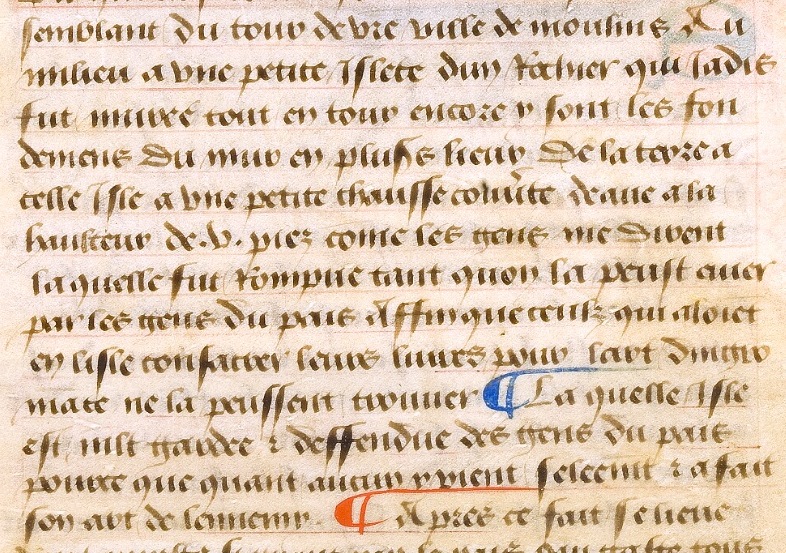

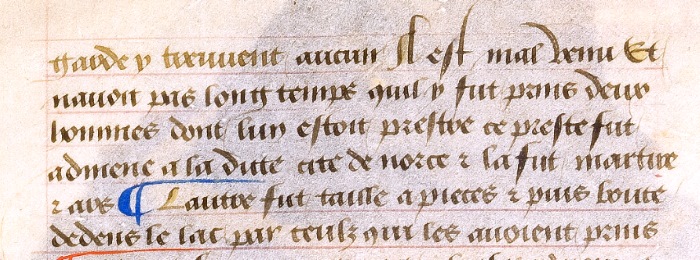

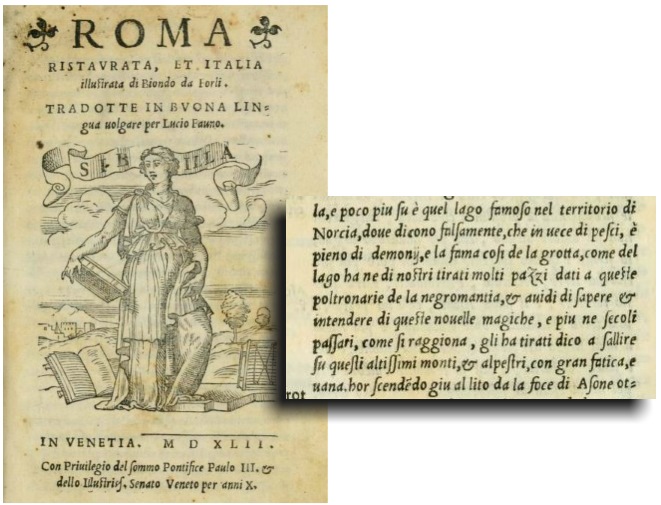

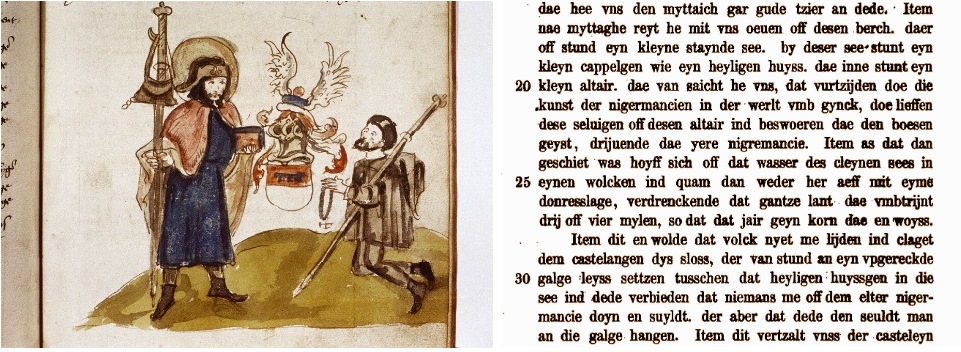

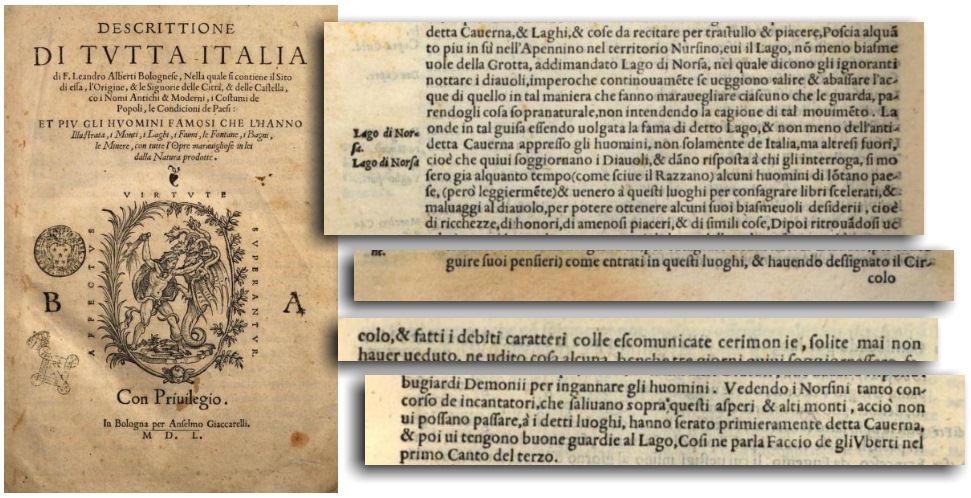

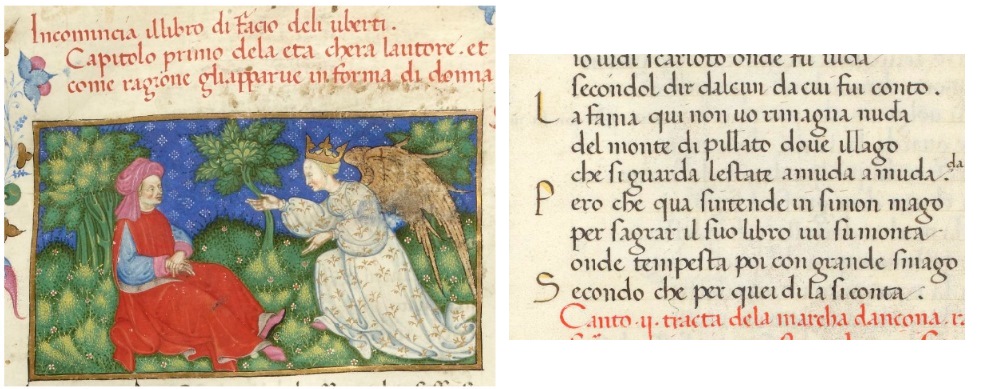

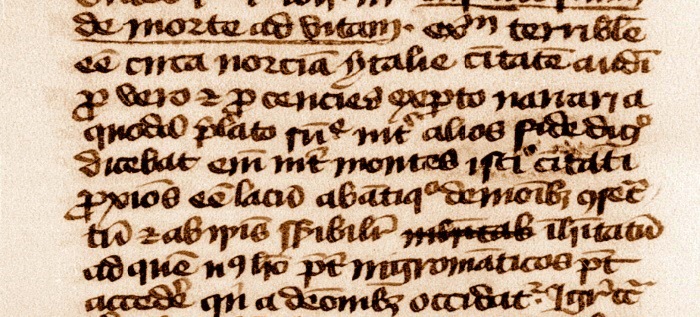

8 Nov 2019
Sibillini Mountain Range, the legend before the legends /2. The common traits
Oddly enough, researchers are accustomed to consider the Sibyl's Cave and the Lakes of Pilate as two thoroughly distinct narratives. The two legends are usually addressed and studied separatedly. The first is a story of an enchanted realm of love and sin concealed beneath a mountain and ruled by a prophetess and sorceress called Sibyl; the second is a tale of a demonic lake, in which the corpse of Pontius Pilate would have ended up its fiendish journey in search of a resting place.
However, there is a factual element that is thoroughly undisputable: we know that the two sites are placed within the same Sibillini Mountain Range, and they are so close to each other that they can even see each other (Fig. 1). How can we be so preposterously blind as to assume that their respective legendary tales are distinct and unrelated?
In order to highlight the common traits shared by both, we had first to reach a full awareness as to the fact that the legends concerning the Apennine Sibyl ad the Lakes of Pilate are both marked by manifest narrative superpositions, as layers and layers of legendary tales born elsewhere and transferred to the Sibillini Mountain Range veil the true core of the local, original myth.
We have shown that the first tale is a superimposed narrative which is derived from a northern-European legendary tradition belonging to the Matter of Britain, concerning magical castles and mountains, and featuring as main characters the necromantic figures of Morgan le Fay and her companion Sebile; the second legend is manifestly an Italian version of the medieval narrative on Pontius Pilate and his cursed corpse, a tale which has established an abode into a small lake nested within the crests of Mount Vettore.
So we find ourselves before two different superimposed legends, which are basically mutually unrelated: a subterranean kingdom ruled by a Sibyl, and a resting place for the cursed body of a Roman prefect. With such unlike superpositions, the Sibyl's Cave and the Pilate's Lake appear to be fully distinct places and legends. So much so that the Sibillini Mountain Range seems to win for itself a peculiar renown as a land able to host many multifarious, dissimilar mythical narratives.
However, actually this is not the case.
When we stop focusing on the figures of the Sibyl (Fig. 2) and Pontius Pilate (Fig. 3), both belonging to a lore which is extraneous to this portion of the Italian territory, we begin to be able to consider different aspects of the legends of the Cave and Lake. Aspects that they have in common. Specific traits that both of them seem to share.
Thus, once we remove the listed legendary superpositions, we start to see the common links which connect the two legends. A glimpse of the possible original legendary core. And not only out of close distance.
In the following paragraphs, we will explore three peculiar aspects that appear to mark both places, the Sibyl's Cave and the Lakes of Pilate. We will highlight their common features, a triple link which connects them together, across the 5.2 miles which separate Mount Sibyl from the glacial cirque of Mount Vettore.
We will analyse necromancy. We will deal with legendary fiendish entities. We will consider tempests and devastation.
The above features will impress their sinister stigma on both sites. Possibly telling us which direction to take if we want to get closer to their common significance, and most veiled secret.
Monti Sibillini: la leggenda prima delle leggende /2. I tratti condivisi
Assai bizzarro appare il fatto che i ricercatori siano soliti considerare la Grotta della Sibilla e i Laghi di Pilato come due narrazioni del tutto distinte. Le due leggende vengono normalmente affrontate e studiate separatamente. La prima racconta la storia di un incantato reame d'amore e di peccato, nascosto al di sotto di una montagna e governato da una profetessa e negromante denominata Sibilla; la seconda narra di un lago demoniaco, nelle cui acque il corpo di Ponzio Pilato avrebbe terminato il proprio viaggio infernale alla ricerca di un luogo di sepoltura.
Eppure, sussiste un elemento fattuale che è assolutamente incontrovertibile: sappiamo che i due siti sono collocati nei medesimi Monti Sibillini, ed essi risultano essere così prossimi l'uno all'altro che i due luoghi risultano essere addirittura mutuamente visibili (Fig. 1). E dunque, come possiamo essere così irragionevolmente ciechi da presumere che le due rispettive narrazioni leggendarie possano essere distinte e autonomamente indipendenti?
Al fine di riuscire a porre in evidenza i tratti comuni che entrambe le leggende condividono, abbiamo prima dovuto raggiungere una piena consapevolezza del fatto che i racconti che riguardano la Sibilla Appenninica e i Laghi di Pilato sono entrambi segnati da evidenti sovrapposizioni narrative, con una presenza di vari livelli di narrazioni leggendarie nate altrove e trasferitesi presso i Monti Sibillini: strati che nascondono il vero nucleo del mito locale originario.
Abbiamo infatti dimostrato come il primo racconto sia costituito da una sovrapposizione narrativa derivata da una tradizione leggendaria di origine nordeuropea appartenente alla Materia di Bretagna, concernente magici castelli e montagne, e che pone in scena, in qualità di protagoniste principali, le figure negromantiche di Morgana la Fata e della sua compagna Sebile; il secondo racconto, invece, è palesemente una versione italiana della narrazione medievale che riguarda Ponzio Pilato e il suo cadavere maledetto, una storia che ha trovato dimora in un piccolo lago circondato dalle alte creste del Monte Vettore.
E così ci troviamo ora di fronte a due diversi strati leggendari, che sono, fondamentalmente, del tutto indipendenti: un regno sotterraneo la cui regina è una Sibilla, e un luogo di sepoltura per il corpo demoniaco di un prefetto romano. Con queste due sovrapposizioni, assai dissimili tra di loro, la Grotta della Sibilla e il Lago di Pilato ci appaiono come due luoghi e due leggende completamente distinti. Talmente distinti da far apparire il territorio dei Monti Sibillini come una landa particolarmente adatta a ospitare varie tipologie di narrazioni mitiche, anche molto assortite.
Ma, a guardare bene, non è proprio questo il caso.
Se cessiamo di focalizzarci sulle figure della Sibilla (Fig. 1) e di Ponzio Pilato (Fig. 2), entrambe appartenenti a tradizioni leggendarie estranee a questa porzione della terra d'Italia, iniziamo a renderci conto che possiamo cominciare a prendere in considerazione altri e differenti aspetti che caratterizzano la Grotta e il Lago. Aspetti che essi hanno in comune. Tratti specifici che entrambi i luoghi sembrano condividere.
E dunque, una volta rimosse le citate sovrapposizioni leggendarie, possiamo cominciare a vedere i legami comuni che connettono tra di loro le due leggende. Un'improvvisa visione del possibile nucleo originale della leggenda. E non solo a motivo della limitata distanza tra i due siti.
Nei prossimi paragrafi, andremo a esplorare tre aspetti peculiari che paiono marcare entrambi i luoghi, la Grotta della Sibilla e i Laghi di Pilato. Evidenzieremo i tratti che essi hanno in comune, un triplice legame che li collega, attraversando la distanza di 8.3 chilometri che separa il Monte Sibilla dal circo glaciale del Monte Vettore.
Ne analizzeremo i caratteri negromantici. Ci confronteremo con leggendarie entità demoniache. Prenderemo in considerazione tempeste e devastazioni.
Sono questi gli aspetti che imprimeranno la propria sinistra impronta su entrambi i siti. Indicandoci, forse, la direzione da prendere se veramente intendiamo avvicinarci al loro comune significato, e al loro più riposto segreto.
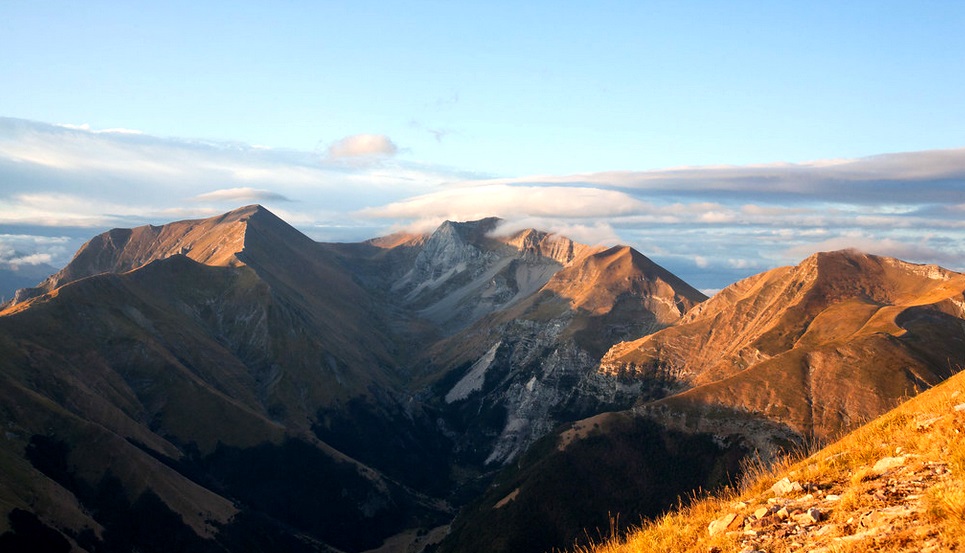

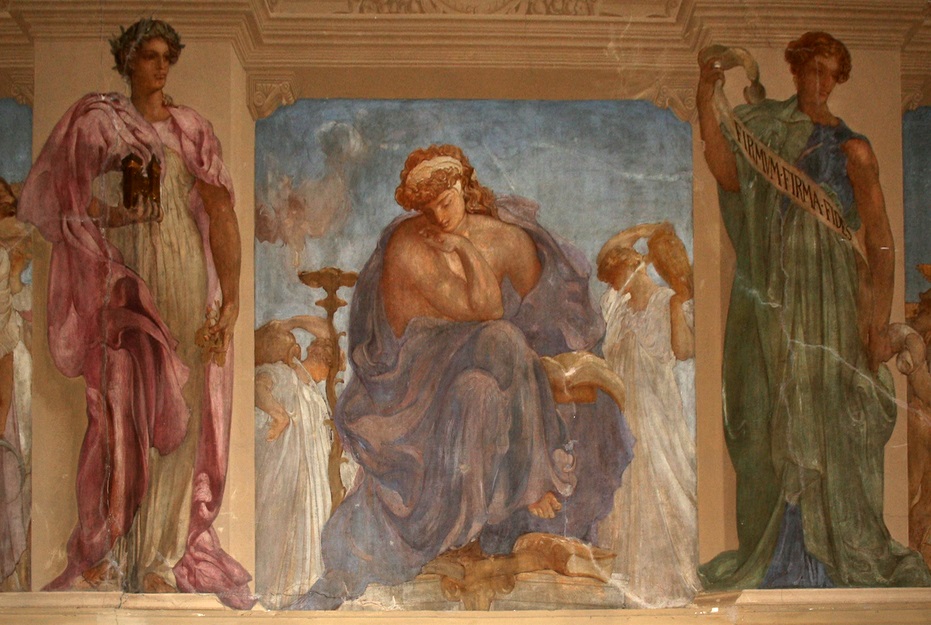

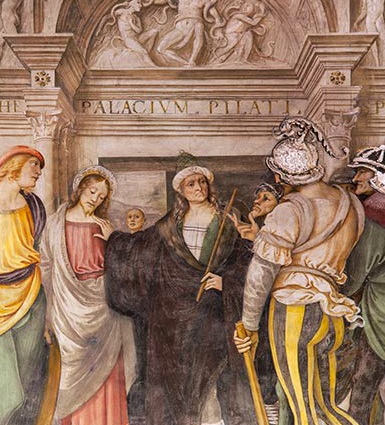

5 Nov 2019
Sibillini Mountain Range: the legend before the legends /1. The Apennine Sibyl and Pontius Pilate don't live here anymore
The Sibillini Mountain Range is a most gorgeous mountainous scenery which raises its lofty peaks in the middle of the Italian peninsula, between the provinces of Marche and Umbria. A portion of the Apennine chain, its impressive fastenesses, marked by dizzying crests and precipitous ravines, are inhabited by sinister legends that were once known throughout Europe, and used to attract many visitors from abroad, in search of the cave of a sensual, prophesying Sibyl, and the lakes in which the dead body of a Roman prefect, Pontius Pilate, was believed to rest unquietly. Two places endowed with a strong mythical spell, featuring different and apparently unrelated tales, and set on different peaks lying only a few miles apart, and in full mutual sight.
Places of daring adventures. Places of mystery and magic. Two sites where a Sibyl of the Apennine had established her legendary subterranean abode, and necromancers went by the rocky shore of a small lake to consecrate their spellbooks.
But where does it all come from? The origin of the legends of the Apennine Sibyl and the Lakes of Pilate was the subject of a comprehensive, in-depth analysis within a series of papers we have released across the last two years.
In "The Knights of the Sibyl - Guerrino and his forefathers" we were able to trace a number of literary ancestors of narrative episodes which are present in the fifteenth-century romance "Guerrino the Wretch", one of the two primary sources for the Apennine Sibyl's legend. In further papers, including "Antoine de La Sale and the magical bridge concealed beneath Mount Sibyl" and "The literary truth about the magical doors in 'The Paradise of Queen Sibyl'", we pointed out the illustrious legendary traditions which lie behind the enchanted contrivances depicted by French gentleman Antoine de la Sale in his fifteenth-century account of a visit to Mount Sibyl, the second fundamental source for the same legend.
The above clues, together with the lack of references to the legend in the centuries which precede the fifteenth, as detailed in the paper "The Apennine Sibyl: a journey into history in search of the oracle", led our enquiry in a direction that had never been sufficiently investigated before: we began to understand that many additional literary layers were concealing the true core of the myth which lived amid the Sibillini Mountain Range, in central Italy.
In this stimulating framework, we confronted with a new exciting task: we needed to identify and clean out the vast collection of literary elements that had been conferred to the two Italian legends throughout hundreds and hundreds of years, from classical antiquity and up to the fifteenth century. Our objective was to get closer and closer to the native core of the legend, so as to unveil the true origin of the fascinating tales of the Sibyl's Cave and Pilate's Lake.
This research work was conducted by addressing the two legends separatedly and one after the other.
In our first paper "Birth of a Sibyl: the medieval connection", we explored the literary layers which seem to have been superimposed to a basic mythical core connected to the presence of a sinister cave on what is known as Mount Sibyl. We soon encountered a number of significant results: 'Sibyl' was a traditional character often recurring within the romances and poems belonging to the Matter of Britain and the Arthurian cycle. Her first appearance as a powerful necromancer, just as powerful as Morgan le Fay, King Arthur's half-sister, dated back to 1185 and the poem "Erec", written by German poet Hartmann von Aue. From that time on, Sibyl began to be staged as Morgan's companion and best friend in many medieval works, with an increasing confusion and mix-up between the figures of the two enchantresses. Lechery, captivity of knights, and magical dwellings set beneath mountains, in one case raising even in Italy, were all characters attached to both necromancers, in their unrelenting journey across the centuries, and through many literary works and an incessant flow of oral narratives, which seemed to point straight to a transplant of a version of their story into the remote peaks of the Sibillini Mountain Range: a mountainous chain which seemed fit enough, for some unspecified reasons, to host a legendary narrative centered on a necromantic Sibyl housed in a cave set beneath a rocky crest. A Sibyl that was not born there, as it is clear that she belongs to a different mythical tradition coming from northern, far-off countries.
A second paper, "A legend for a Roman prefect: the Lakes of Pontius Pilate", was devoted to a thorough exploration of the myth of the Lake of Pilate in the Sibillini Mountain Range. In this specific case, the task to remove the additional legendary layers proved to be much easier. It is actually well known to scholars the story and origin of the legend of Pilate, which concerns its multiple, demonic burial places scattered across a number of sites in Europe, including Vienne and the river Rhône, in France, Saint-Chamond in the same country, Lausanne and Lucerne in the Swiss Alps. Following the footsteps of this ancient legend from the classical authors into the Middle Ages, we found out that no mention of the Sibillini Mountain Range as one of Pilate's resting place is ever found, and we are forced to get to Antoine de la Sale to retrieve the first reference of this sort. Once again, it was easy to show that no Pontius Pilate has ever been cast into the small lake nested within the glacial cirque of Mount Vettore, the most impressive peak in the Sibillini Mountain Range: as for the Sibyl's Cave, the site had been able to attract a legendary narrative which did not belong to, nor was originated from, this Italian setting.
On concluding the two listed papers, we could set down the new questions that would be at the center of our subsequent research work: what sort of magnetic pull did attract the magical tales of the Arthurian cycle on the sinister peak of Mount Sibyl? Why a gloomy tale concerning the cursed burial place of Pontius Pilate did come to settle right in the middle of what we know today as the Sibillini Mountain Range, in the Italian Apennines? For what kind of fated chance did such foreign legends come to rest, like a ball spinning on a roulette wheel, right into the positions marked by these remote Italian mountain and lake?
We knew, for sure, that this has not happened by mere chance.
We believe that a legend, some sort of native, original myth was already there before the Apennine Sibyl and Pontius Pilate came to these territory with their foreign, extraneous narratives.
The Cave and Lake were already inhabited by an earlier legendary tale. And, subsequently, the tales on a chivalric Sibyl queen and a burial place for Pontius Pilate established themselves right here, under the mythical pull of the two sites set in the Sibillini Mountain Range. Centuries of oral narratives and then literary works brought the two listed foreign legends here, and they found a most fit and inviting setting where to settle down.
This is the fundamental issue of our whole search, the most critical one: it actually appears that both the Lakes of Pilate and the Apennine Sibyl arose from some odd condensation of a peculiar nature which marks this place, the Sibillini Mountain Range. There is a sort of original core pertaining to both myths: a legend before the legends, something that was not transplanted from any other place or tradition, something that was born right here instead, and possibly connected to the fact that this location is some sort of very special site.
In this new paper, we will start to address this odd condensation. We intend to highlight the peculiar nature of this remote corner of the land of Italy.
To achieve this goal, we will first try to understand what the Sibyl's Cave and the Pilate's Lakes have in common as to their legendary renown. Are their respective mythical traits utterly different? Or, maybe, do they feature anything which connects them one another?
Can we get a glimpse of their potential, yet still unknown, common legendary core, if any?
If we were able to detect any shared features which link the two legends of the Sibyl's Cave and the Pilate's Lake together, we would be on the verge of a new exciting finding: the two legends might be closely tied, owing to specific common traits that mark both of them.
And we might even succeed in understanding why they have been able to unleash so powerful a might as to attract illustrious, outlandish mythical narratives, such the ones concerning a chivalric Sibyl and the cursed body of Pontius Pilate, into their sinister gloominess, set at the very centre of Italy.
Let's start a new travel. This time we will not be looking for superimposed layers, belonging to distinct, unrelated legendary traditions. This time we will be looking for what the Cave and Lakes share together.
We will be hunting for common attributes. And we will find out many of them.
Monti Sibillini: la leggenda prima delle leggende /1. La Sibilla Appenninica e Ponzio Pilato non abitano più qui
I Monti Sibillini costituiscono uno straordinario scenario che innalza le proprie vette al centro della penisola italiana, tra le regioni delle Marche e dell'Umbria. Parte della catena appenninica, i loro formidabili bastioni, caratterizzati dalla presenza di creste vertiginose e spaventosi precipizi, sono abitati da sinistre leggende un tempo conosciute in tutta Europa, capaci di attirare schiere di visitatori da paesi assai lontani, alla ricerca della caverna nella quale si diceva dimorasse una sensuale profetessa, una Sibilla, e del lago nel quale si riteneva che il corpo di un antico prefetto romano, Ponzio Pilato, conoscesse un inquieto riposo. Due luoghi illuminati da un'intensa fascinazione mitica, caratterizzati da due narrazioni differenti e apparentemente non correlate, e posizionati su vette diverse separate solamente da pochi chilometri di distanza, in piena linea visuale reciproca.
Luoghi di ardite avventure. Luoghi di magia e mistero. Due siti, una caverna al cui interno una Sibilla degli Appennini aveva stabilito la propria leggendaria dimora sotterranea, e le rive rocciose di un piccolo lago, presso il quale i negromanti si recavano per consacrare i propri libri magici.
Ma da dove viene tutto ciò? L'origine delle leggende della Sibilla Appenninica e dei Laghi di Pilato è stata oggetto di un'analisi approfondita ed esaustiva nell'ambito di una serie di articoli da noi pubblicati nel corso degli ultimi due anni.
Ne "I Cavalieri della Sibilla - Guerrin Meschino e i suoi antecedenti" siamo stati in grado di identificare una serie di ascendenti letterari relativi ad alcuni episodi narrativi presenti nel romanzo quattrocentesco "Guerrin Meschino", una delle due fonti principali della leggenda concernente la Sibilla Appenninica. Con ulteriori articoli, tra i quali "Antoine de La Sale e il magico ponte nascosto nel Monte della Sibilla" e "La verità letteraria sulle magiche porte nel 'Paradiso della Regina Sibilla'", abbiamo posto in evidenza le illustri tradizioni letterarie che si nascondono dietro agli incantati meccanismi descritti dal gentiluomo provenzale Antoine de la Sale nel suo quattrocentesco resoconto di una visita al Monte Sibilla, la seconda principale fonte che narra di questa leggenda.
I predetti indizi, assieme alla mancanza di ogni riferimento alla leggenda sibillina nei secoli che precedono il quindicesimo, come illustrato nell'articolo "Sibilla Appenninica: un viaggio nella storia alla ricerca dell'oracolo", hanno indirizzato la nostra investigazione verso una direzione che non è mai stata sufficientemente esplorata in precedenza: abbiamo infatti cominciato a comprendere come molteplici strati letterari aggiuntivi stessero occultando il nucleo più vero del mito che abitava tra le vette dei Monti Sibillini, nell'Italia centrale.
In questo stimolante contesto, è stato necessario affrontare una nuova e ambiziosa problematica: si trattava di identificare e rimuovere la corposa mole di elementi letterari che si era venuta ad aggiungere alla leggenda italiana attraverso centinaia e centinaia di anni, dall'antichità e fino al quindicesimo secolo. Il nostro obiettivo diventava quello di avvicinarci sempre di più al cuore originario della leggenda, in modo da potere finalmente disvelare la vera matrice degli affascinanti racconti relativi alla Grotta della Sibilla e al Lago di Pilato.
Questa attività di ricerca è stata condotta affrontando le due leggende separatamente, e in successione l'una rispetto all'altra.
Nel nostro primo articolo "Nascita di una Sibilla: la traccia medievale", abbiamo esplorato gli strati letterari che risultano essere stati sovrapposti al nucleo mitico primitivo connesso alla presenza di una sinistra caverna sulla vetta di ciò che oggi conosciamo con il nome di Monte Sibilla. Ci siamo subito imbattuti in una serie di risultanze assai significative: 'Sibilla', infatti, è un personaggio tradizionale che appare in modo ricorrente in romanzi e poemi appartenenti alla Materia di Bretagna e al Ciclo Arturiano. La sua prima apparizione in qualità di potente negromante, proprio come Fata Morgana, la famosa sorellastra di Re Artù, risale al 1185, con il poema "Erec", scritto dal poeta tedesco Hartmann von Aue. A partire da quest'opera, e per i secoli a seguire, Sibilla comincia a essere rappresentata come compagna e migliore amica di Morgana in molti componimenti medievali, con una crescente confusione e commistione tra le figure delle due incantatrici. Sensualità, cavalieri imprigionati e magiche dimore situate al di sotto di montagne, in un caso localizzate addirittura in Italia, costituiscono tutti caratteri associati con entrambe le negromanti, nel corso del loro ininterrotto viaggio attraverso i secoli, e attraverso molte opere letterarie e un incessante fluire di narrazioni orali, che sembrano puntare direttamente verso l'insediamento di una versione della loro storia tra i remoti picchi dei Monti Sibillini: una catena montuosa che parrebbe sufficientemente adatta, per qualche imprecisato motivo, a ospitare una narrazione leggendaria incentrata su di una negromantica Sibilla dimorante in una caverna posta al di sotto di una cresta rocciosa. Una Sibilla che non è nata in questi luoghi, appartenendo essa a una differente tradizione mitica, che proviene da regioni settentrionali e distanti.
Un secondo articolo, "Una leggenda per un prefetto romano: i Laghi di Ponzio Pilato", ha operato una completa esplorazione del mito del Lago di Pilato, posto tra i Monti Sibillini. In questa specifica investigazione, il compito di identificare e rimuovere i livelli leggendari aggiuntivi è risultato essere assai più facile. Sono infatti ben note agli studiosi le vicende e l'origine della leggenda di Pilato, che riguarda i suoi molteplici e demoniaci luoghi di sepoltura, distribuiti su vari siti in Europa, tra i quali Vienne e il fiume Rodano, in Francia, Saint-Chamond nella stessa regione, Losanna e Lucerna nelle Alpi svizzere. Seguendo le tracce di questa antica leggenda a partire dagli autori classici e fino al Medioevo, si scopre come non sia rinvenibile alcun riferimento ai Monti Sibillini in qualità di luogo di sepoltura di Pilato, trovandoci costretti a giungere fino ad Antoine de la Sale per potere reperire la prima menzione in tal senso. Ancora una volta, risulta facile dimostrare come nessun Ponzio Pilato sia mai stato gettato nelle acque del piccolo lago incastonato all'interno del circo glaciale del Monte Vettore, la vetta più impressionante dei Monti Sibillini: come abbiamo già potuto rilevare anche per la Sibilla, quel sito è stato capace di attrarre a sé una narrazione leggendaria che non appartiene, né trova origine, in questa porzione d'Italia.
A conclusione dei due articoli citati, abbiamo potuto definire le nuove domande che sarebbero state al centro del nostro successivo impegno di ricerca: quale sorta di magnetica attrazione ha attirato i magici racconti del Ciclo Arturiano sulla sinistra vetta del Monte Sibilla? E perché un tenebroso racconto concernente il maledetto luogo di sepoltura di Ponzio Pilato è giunto a stabilirsi proprio al centro di ciò che oggi conosciamo come i Monti Sibillini, nella catena appenninica? Per quale genere di fatale combinazione queste leggende nate altrove sono venute ad arrestarsi, come una sfera carambolante sul disco di una roulette, precisamente nelle posizioni segnate da questa isolata montagna e da questo remoto lago dell'Italia centrale?
Sappiamo, con estrema sicurezza, che ciò non è avvenuto per puro caso.
Siamo convinti che una leggenda, un qualche genere di mito nativo, originario, fosse già lì prima che la Sibilla Appenninica e Ponzio Pilato giungessero qui con le proprie estranee narrazioni, nate altrove.
La Grotta e il Lago erano già abitati da un precedente racconto leggendario. E, successivamente, i racconti relativi a una cavalleresca regina Sibilla e a un luogo di sepoltura per Ponzio Pilato vennero a stabilirsi esattamente qui, sotto la mitica attrazione esercitata dai due siti posti tra i Monti Sibillini. Secoli e secoli di narrazioni orali e poi di componimenti letterari hanno condotto le due leggende fin qui, dove esse furono in grado di trovare un'ambientazione particolarmente appropriata e invitante presso la quale radicarsi.
È questa la questione fondamentale di tutta la nostra ricerca, la domanda maggiormente critica: sembra plausibile ipotizzare che sia i Laghi di Pilato che la Sibilla Appenninica siano sorti da una particolare condensazione relativa, in modo specifico, alla natura di questi luoghi, i Monti Sibillini. Pare sussistere una sorta di nucleo originario, pertinente a entrambi i miti: una leggenda prima delle leggende, qualcosa che non fu trapiantato tra queste montagne giungendo da altri luoghi e tradizioni, qualcosa che ebbe invece origine esattamente qui, e forse collegato con il fatto che questi siti rappresentano luoghi molto speciali.
In questo nuovo articolo, inizieremo ad affrontare questa strana condensazione. Il nostro intento sarà quello di porre in luce la peculiare natura di questo angolo d'Italia.
Per raggiungere questo obiettivo, dovremo prima comprendere quali caratteri possano avere in comune la Grotta della Sibilla e i Laghi di Pilato, in termini di fama leggendaria. Le due leggende sono caratterizzate da tratti mitici del tutto differenti? Oppure, esistono specifici aspetti che le accomunano e le collegano?
Siamo in grado di intravedere ciò che dovrebbe costituire il loro possibile, seppure ancora ignoto, comune nucleo leggendario, se davvero esso esiste?
Se saremo capaci di rilevare eventuali caratteristiche comuni che connettono tra di loro le due leggende, la Grotta della Sibilla e i Laghi di Pilato, ci troveremo sull'orlo di una nuova emozionante scoperta: le due leggende potrebbero risultare essere strettamente legate, come segnalato da quegli specifici aspetti condivisi che marcherebbero entrambe.
E potremmo allora riuscire a capire perché esse siano state in grado di sviluppare una potenza mitica così intensa da attrarre a sé narrazioni leggendarie così illustri e così distanti, come quelle che riguardano una cavalleresca Sibilla e il corpo maledetto di Ponzio Pilato, calamitate fino alla sinistra oscurità di questi luoghi, posti nel centro dell'Italia.
Cominciamo dunque un nuovo viaggio. Questa volta non ci metteremo alla ricerca di livelli narrativi aggiuntivi, appartenenti a tradizioni leggendarie estranee e differenti. Questa volta andremo in cerca di ciò che la Grotta e i Laghi condividono assieme.
Andremo a caccia dei tratti comuni. E, come si vedrà, ne troveremo parecchi.
